publications
2025
-
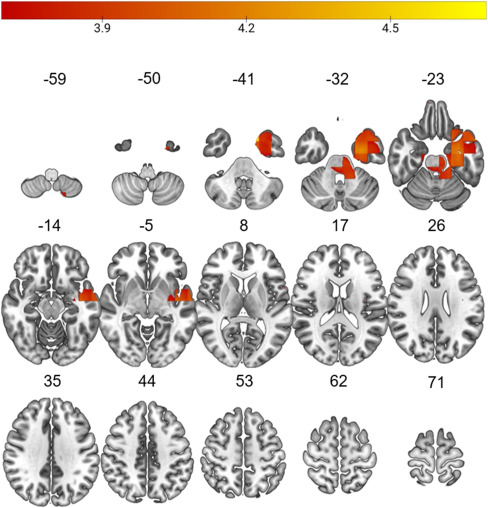 Metabolic Status Modulates Global and Local Brain Age Estimates in Overweight and Obese AdultsShalaila S Haas, Fahim Abbasi, Kathleen Watson, and 4 more authorsBiological Psychiatry: Cognitive Neuroscience and Neuroimaging, Mar 2025
Metabolic Status Modulates Global and Local Brain Age Estimates in Overweight and Obese AdultsShalaila S Haas, Fahim Abbasi, Kathleen Watson, and 4 more authorsBiological Psychiatry: Cognitive Neuroscience and Neuroimaging, Mar 2025Background As people live longer, maintaining brain health becomes essential for extending healthspan and preserving independence. Brain degeneration and cognitive decline are major contributors to disability. This study investigates how metabolic health influences brain-age-gap-estimate (brainAGE), which measures the difference between neuroimaging-predicted brain age and chronological age. Methods K-means clustering was applied to fasting metabolic markers including insulin, glucose, leptin, cortisol, triglycerides, high-density lipoprotein cholesterol and low-density lipoprotein cholesterol, steady-state-plasma glucose and of body mass index of 114 physically and cognitively healthy adults. The Homeostatic Model Assessment for Insulin Resistance served as a reference. T1-weighted brain MRIs were used to calculate voxel-level and global (G-brainAGE). Longitudinal data were available for 53 participants over a 3-year interval. Results K-mean clustering divided the sample into two groups: those with favorable (N=56) and suboptimal metabolic health (N=58). The suboptimal group showed signs of insulin resistance and dyslipidemia (PFDR<0.05) and had older G-brainAGE and L-brainAGE, with deviations most prominent in cerebellar, ventromedial prefrontal, and medial temporal regions (PFWE<0.05). Longitudinal analysis revealed group differences but no significant time or interaction effects on brainAGE measures. Conclusions Suboptimal metabolic status is linked to accelerated brain aging, particularly in brain regions rich in insulin receptors. These findings highlight the importance of metabolic health in maintaining brain function and suggest that promoting metabolic well-being may help extend healthspan.
@article{haas2025metabolic, title = {Metabolic Status Modulates Global and Local Brain Age Estimates in Overweight and Obese Adults}, author = {Haas, Shalaila S and Abbasi, Fahim and Watson, Kathleen and Robakis, Thalia and Myoraku, Alison and Frangou, Sophia and Rasgon, Natalie}, journal = {Biological Psychiatry: Cognitive Neuroscience and Neuroimaging}, year = {2025}, month = mar, publisher = {Elsevier}, }
2024
-
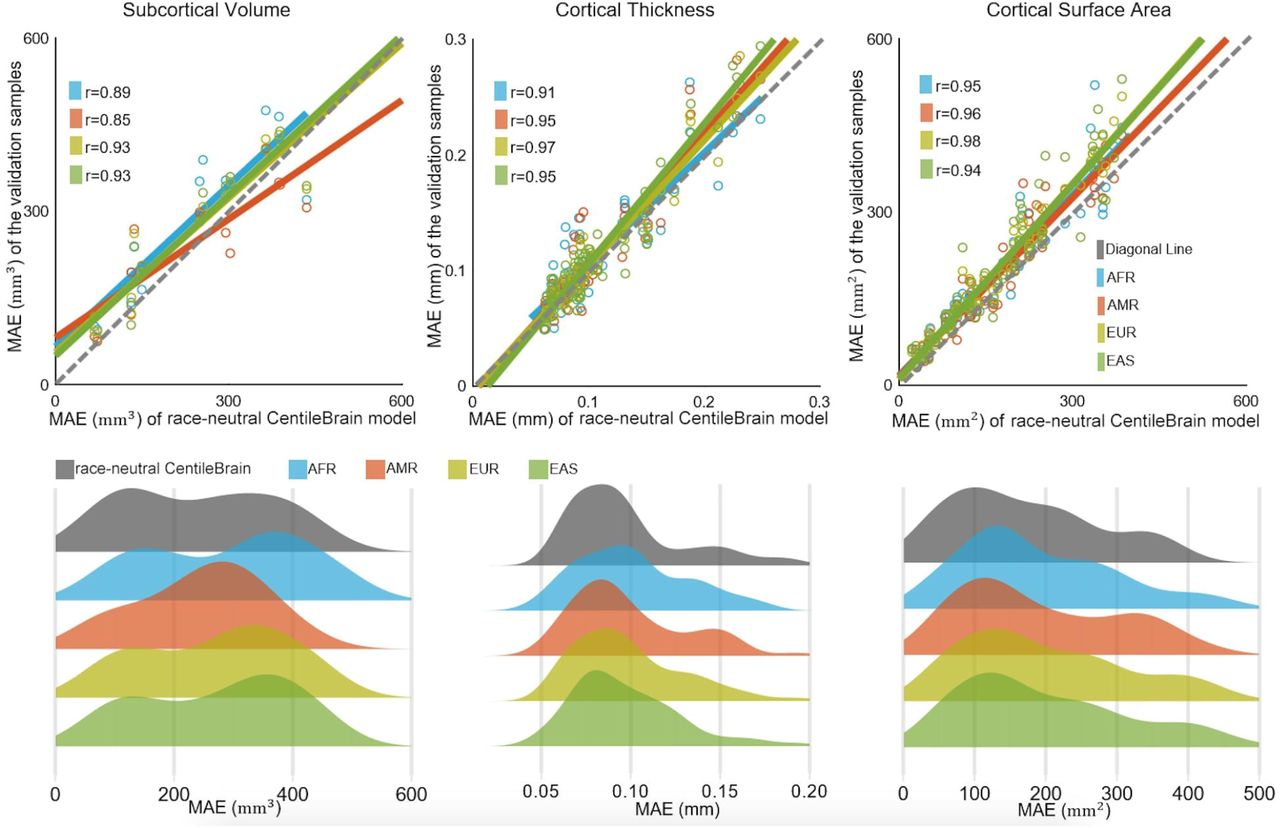 Generalizability of Normative Models of Brain Morphometry Across Distinct Ethnoracial GroupsRuiyang Ge, Yuetong Yu, Faye New, and 8 more authorsBioRxiv, Oct 2024
Generalizability of Normative Models of Brain Morphometry Across Distinct Ethnoracial GroupsRuiyang Ge, Yuetong Yu, Faye New, and 8 more authorsBioRxiv, Oct 2024Normative modeling of brain morphometric data can inform about the clinical significance of deviations from typical patterns in brain structure. Their usefulness, however, is dependent on their applicability to diverse ethnoracial groups. With this in mind, we developed age- and sex-specific normative models for cortical thickness, surface area, and subcortical volumes using brain scans from 37,407 healthy individuals from a diverse international sample. Here we demonstrate the validity of these models in diverse and distinct populations. Specifically, we tested these pre-trained models on independent samples of healthy individuals that either self-identified as Black, South Asian, East Asian Chinese, East Asian Japanese, or we categorized as African, Admixed American, East Asian, and European based on their genetic ancestry. Regardless of ethnoracial definition, the performance of the pretrained models in these samples was exceptionally high; the relative mean absolute error for each regional brain morphometry measure was less than 10% across all the distinct ethnoracial groups. These findings affirm the broad applicability of our models, ensuring that brain morphometry assessments using these models are accurate and reliable for individuals regardless of background. This broad applicability has significant implications for advancing personalized medicine and improving health outcomes in diverse populations.
@article{ge2024generalizability, title = {Generalizability of Normative Models of Brain Morphometry Across Distinct Ethnoracial Groups}, author = {Ge, Ruiyang and Yu, Yuetong and New, Faye and Haas, Shalaila S and Sanford, Nicole and Yu, Kevin and Leon, Julian Camillo Becerra and Yang, Guoyuan and Gao, Jia-Hong and Nemoto, Kiyotaka and others}, journal = {BioRxiv}, pages = {2024--10}, month = oct, year = {2024}, publisher = {Cold Spring Harbor Laboratory}, } -
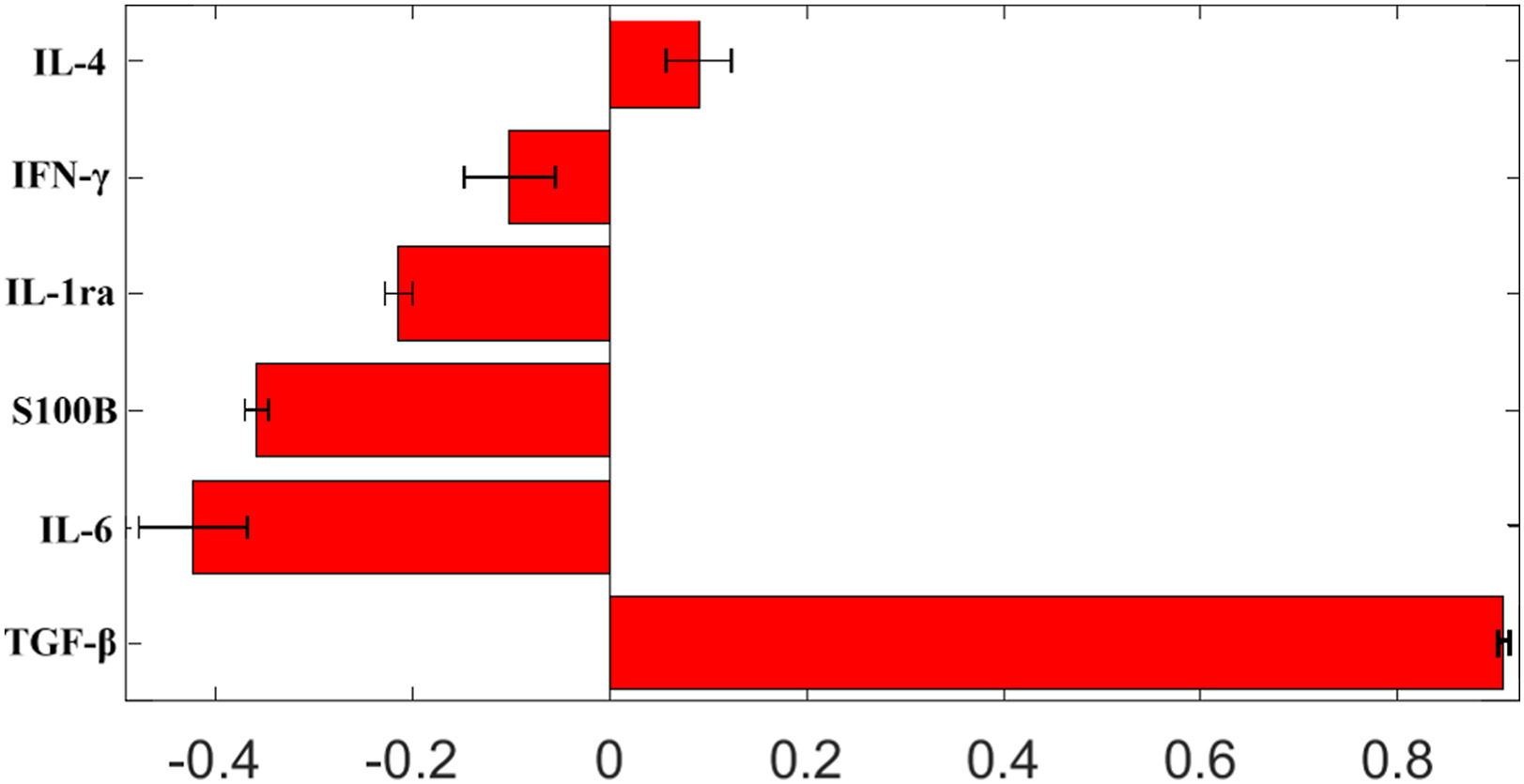 Anhedonia as a potential transdiagnostic phenotype with immune-related changes in recent-onset mental health disordersParis Alexandros Lalousis, Aanya Malaviya, Ali Khatibi, and 8 more authorsBiological Psychiatry, Oct 2024
Anhedonia as a potential transdiagnostic phenotype with immune-related changes in recent-onset mental health disordersParis Alexandros Lalousis, Aanya Malaviya, Ali Khatibi, and 8 more authorsBiological Psychiatry, Oct 2024Background Chronic low-grade inflammation is observed across mental disorders and is associated with difficult-to-treat-symptoms of anhedonia and functional brain changes, reflecting a potential transdiagnostic dimension. Previous investigations have focused on distinct illness categories in people with enduring illness, but few have explored inflammatory changes. We sought to identify an inflammatory signal and the associated brain function underlying anhedonia among young people with recent-onset psychosis and recent-onset depression. Methods Resting-state functional magnetic resonance imaging, inflammatory markers, and anhedonia symptoms were collected from 108 (mean [SD] age = 26.2 [6.2] years; female = 50) participants with recent-onset psychosis (n = 53) and recent-onset depression (n = 55) from the European Union/Seventh Framework Programme–funded PRONIA (Personalised Prognostic Tools for Early Psychosis Management) study. Time series were extracted using the Schaefer atlas, defining 100 cortical regions of interest. Using advanced multimodal machine learning, an inflammatory marker model and a functional connectivity model were developed to classify participants into an anhedonic group or a normal hedonic group. Results A repeated nested cross-validation model using inflammatory markers classified normal hedonic and anhedonic recent-onset psychosis/recent-onset depression groups with a balanced accuracy of 63.9% and an area under the curve of 0.61. The functional connectivity model produced a balanced accuracy of 55.2% and an area under the curve of 0.57. Anhedonic group assignment was driven by higher levels of interleukin 6, S100B, and interleukin 1 receptor antagonist and lower levels of interferon gamma, in addition to connectivity within the precuneus and posterior cingulate. Conclusions We identified a potential transdiagnostic anhedonic subtype that was accounted for by an inflammatory profile and functional connectivity. Results have implications for anhedonia as an emerging transdiagnostic target across emerging mental disorders.
@article{lalousis2024anhedonia, title = {Anhedonia as a potential transdiagnostic phenotype with immune-related changes in recent-onset mental health disorders}, author = {Lalousis, Paris Alexandros and Malaviya, Aanya and Khatibi, Ali and Saberi, Majid and Kambeitz-Ilankovic, Lana and Haas, Shalaila S and Wood, Stephen J and Barnes, Nicholas M and Rogers, Jack and Chisholm, Katharine and others}, journal = {Biological Psychiatry}, volume = {96}, number = {7}, pages = {615--622}, month = oct, year = {2024}, publisher = {Elsevier}, } -
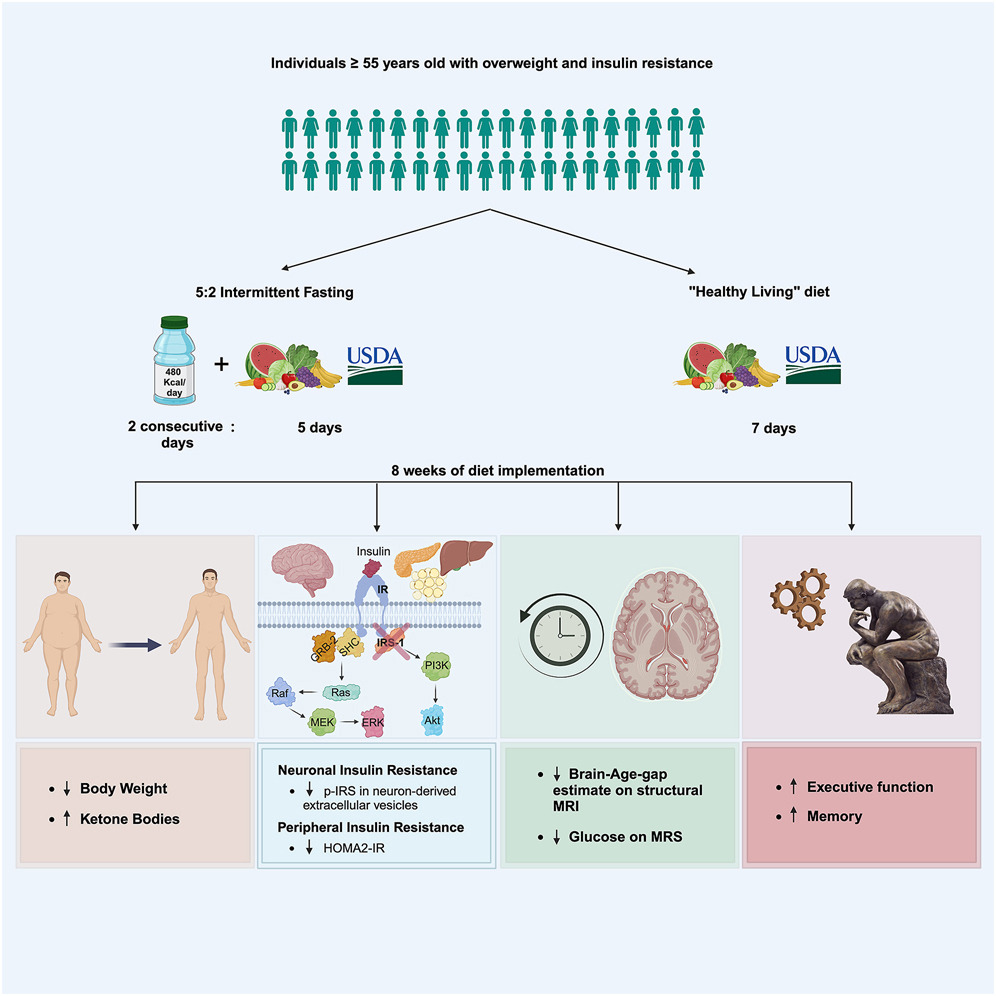 Brain responses to intermittent fasting and the healthy living diet in older adultsDimitrios Kapogiannis, Apostolos Manolopoulos, Roger Mullins, and 8 more authorsCell metabolism, Aug 2024
Brain responses to intermittent fasting and the healthy living diet in older adultsDimitrios Kapogiannis, Apostolos Manolopoulos, Roger Mullins, and 8 more authorsCell metabolism, Aug 2024Diet may promote brain health in metabolically impaired older individuals. In an 8-week randomized clinical trial involving 40 cognitively intact older adults with insulin resistance, we examined the effects of 5:2 intermittent fasting and the healthy living diet on brain health. Although intermittent fasting induced greater weight loss, the two diets had comparable effects in improving insulin signaling biomarkers in neuron-derived extracellular vesicles, decreasing the brain-age-gap estimate (reflecting the pace of biological aging of the brain) on magnetic resonance imaging, reducing brain glucose on magnetic resonance spectroscopy, and improving blood biomarkers of carbohydrate and lipid metabolism, with minimal changes in cerebrospinal fluid biomarkers for Alzheimer’s disease. Intermittent fasting and healthy living improved executive function and memory, with intermittent fasting benefiting more certain cognitive measures. In exploratory analyses, sex, body mass index, and apolipoprotein E and SLC16A7 genotypes modulated diet effects. The study provides a blueprint for assessing brain effects of dietary interventions and motivates further research on intermittent fasting and continuous diets for brain health optimization. For further information, please see ClinicalTrials.gov registration: NCT02460783.
@article{kapogiannis2024brain, title = {Brain responses to intermittent fasting and the healthy living diet in older adults}, author = {Kapogiannis, Dimitrios and Manolopoulos, Apostolos and Mullins, Roger and Avgerinos, Konstantinos and Delgado-Peraza, Francheska and Mustapic, Maja and Nogueras-Ortiz, Carlos and Yao, Pamela J and Pucha, Krishna A and Brooks, Janet and others}, journal = {Cell metabolism}, volume = {36}, number = {8}, pages = {1668--1678}, month = aug, year = {2024}, publisher = {Elsevier}, } -
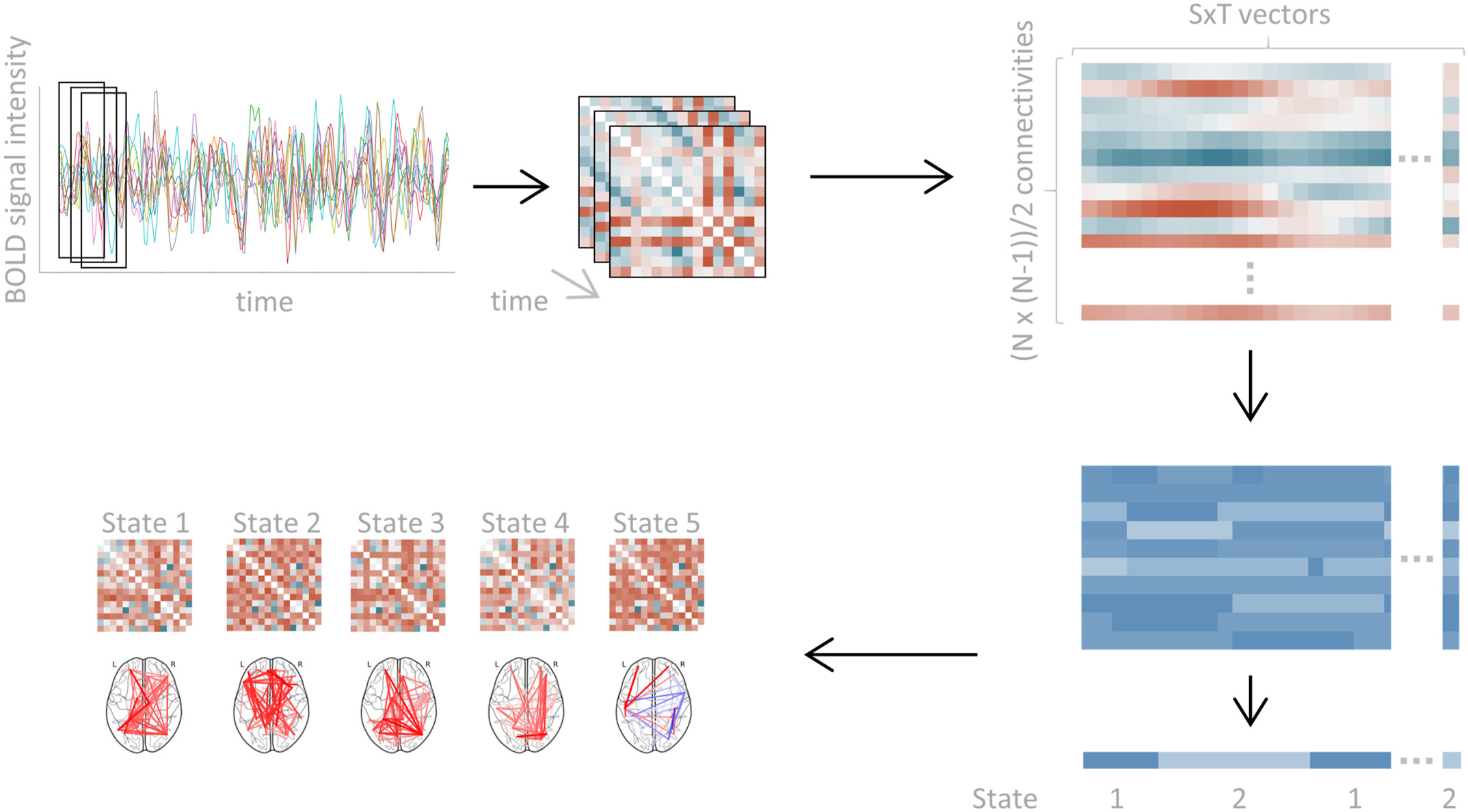 Alterations of Functional Connectivity Dynamics in Affective and Psychotic DisordersLinnea Hoheisel, Lana Kambeitz-Ilankovic, Julian Wenzel, and 8 more authorsBiological Psychiatry: Cognitive Neuroscience and Neuroimaging, Aug 2024
Alterations of Functional Connectivity Dynamics in Affective and Psychotic DisordersLinnea Hoheisel, Lana Kambeitz-Ilankovic, Julian Wenzel, and 8 more authorsBiological Psychiatry: Cognitive Neuroscience and Neuroimaging, Aug 2024Background Patients with psychosis and patients with depression exhibit widespread neurobiological abnormalities. The analysis of dynamic functional connectivity (dFC) allows for the detection of changes in complex brain activity patterns, providing insights into common and unique processes underlying these disorders. Methods We report the analysis of dFC in a large sample including 127 patients at clinical high risk for psychosis, 142 patients with recent-onset psychosis, 134 patients with recent-onset depression, and 256 healthy control participants. A sliding window–based technique was used to calculate the time-dependent FC in resting-state magnetic resonance imaging data, followed by clustering to reveal recurrent FC states in each diagnostic group. Results We identified 5 unique FC states, which could be identified in all groups with high consistency (mean r = 0.889 [SD = 0.116]). Analysis of dynamic parameters of these states showed a characteristic increase in the lifetime and frequency of a weakly connected FC state in patients with recent-onset depression (p < .0005) compared with the other groups and a common increase in the lifetime of an FC state characterized by high sensorimotor and cingulo-opercular connectivities in all patient groups compared with the healthy control group (p < .0002). Canonical correlation analysis revealed a mode that exhibited significant correlations between dFC parameters and clinical variables (r = 0.617, p < .0029), which was associated with positive psychosis symptom severity and several dFC parameters. Conclusions Our findings indicate diagnosis-specific alterations of dFC and underline the potential of dynamic analysis to characterize disorders such as depression and psychosis and clinical risk states.
@article{hoheisel2024alterations, title = {Alterations of Functional Connectivity Dynamics in Affective and Psychotic Disorders}, author = {Hoheisel, Linnea and Kambeitz-Ilankovic, Lana and Wenzel, Julian and Haas, Shalaila S and Antonucci, Linda A and Ruef, Anne and Penzel, Nora and Schultze-Lutter, Frauke and Lichtenstein, Theresa and Rosen, Marlene and others}, journal = {Biological Psychiatry: Cognitive Neuroscience and Neuroimaging}, volume = {9}, number = {8}, pages = {765--776}, month = aug, year = {2024}, publisher = {Elsevier}, } -
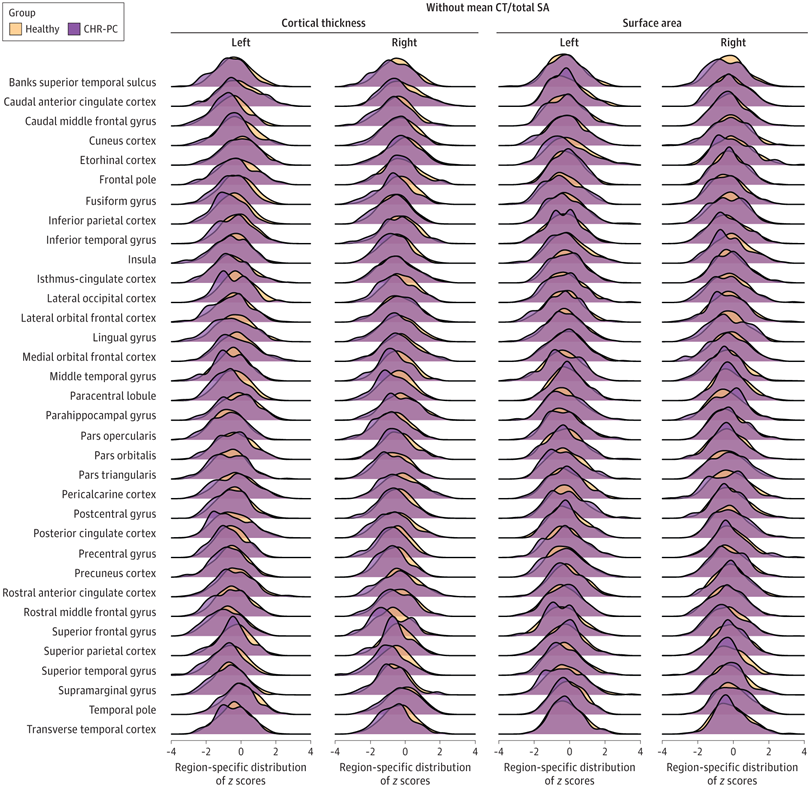 Brain Morphometry Normative Modeling—Omit Global Thickness—ReplyShalaila S Haas, Ruiyang Ge, and Sophia FrangouJAMA psychiatry, Jul 2024
Brain Morphometry Normative Modeling—Omit Global Thickness—ReplyShalaila S Haas, Ruiyang Ge, and Sophia FrangouJAMA psychiatry, Jul 2024@article{haas2024brain, title = {Brain Morphometry Normative Modeling—Omit Global Thickness—Reply}, author = {Haas, Shalaila S and Ge, Ruiyang and Frangou, Sophia}, journal = {JAMA psychiatry}, volume = {81}, number = {8}, pages = {844--846}, month = jul, year = {2024}, publisher = {American Medical Association}, } -
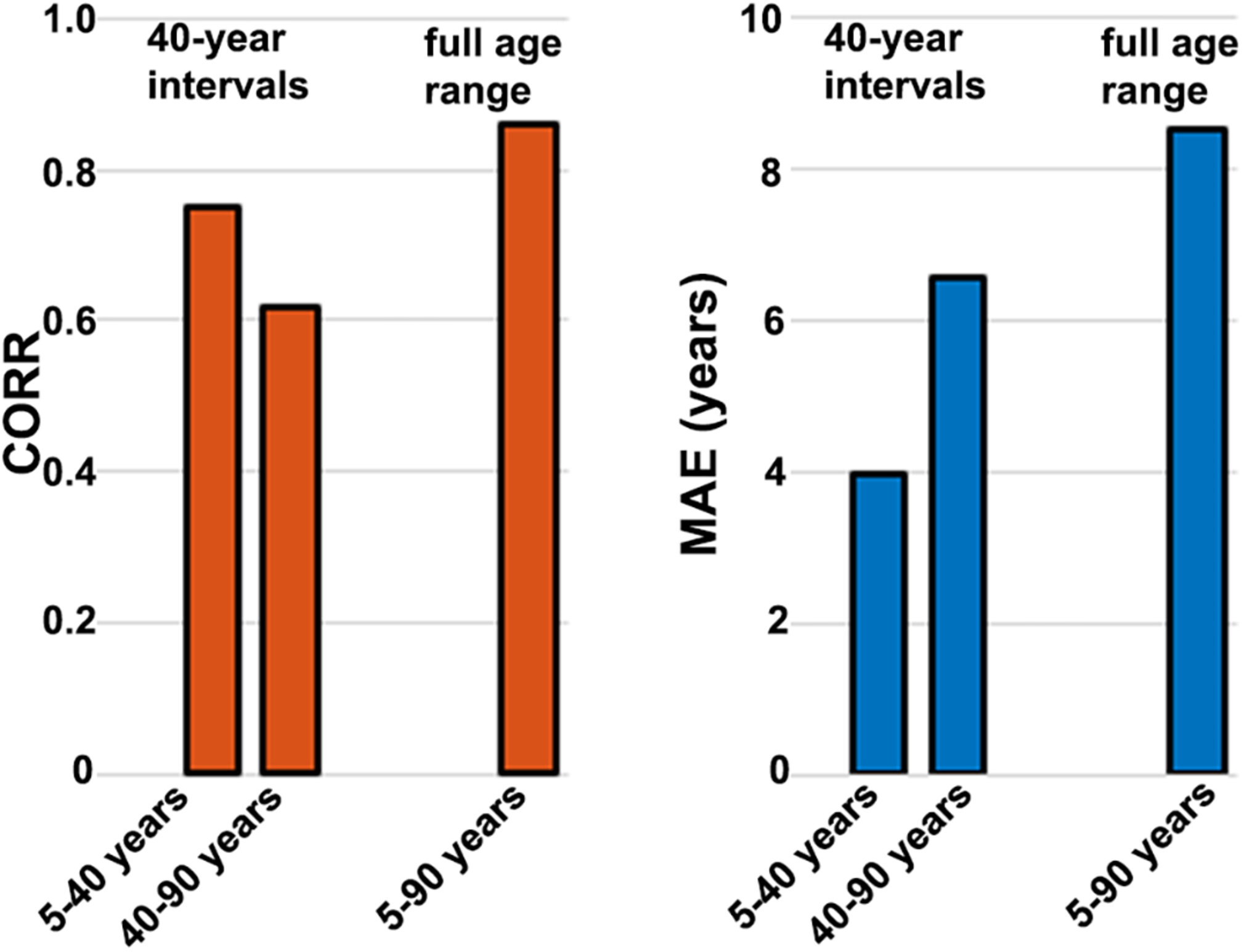 Brain-Age Prediction: Systematic Evaluation of Site Effects, and Sample Age Range and SizeYuetong Yu, Hao Qi Cui, Shalaila Haas, and 8 more authorsBiological Psychiatry, Jul 2024
Brain-Age Prediction: Systematic Evaluation of Site Effects, and Sample Age Range and SizeYuetong Yu, Hao Qi Cui, Shalaila Haas, and 8 more authorsBiological Psychiatry, Jul 2024Structural neuroimaging data have been used to compute an estimate of the biological age of the brain (brain-age) which has been associated with other biologically and behaviorally meaningful measures of brain development and aging. The ongoing research interest in brain-age has highlighted the need for robust and publicly available brain-age models pre-trained on data from large samples of healthy individuals. To address this need we have previously released a developmental brain-age model. Here we expand this work to develop, empirically validate, and disseminate a pre-trained brain-age model to cover most of the human lifespan. To achieve this, we selected the best-performing model after systematically examining the impact of seven site harmonization strategies, age range, and sample size on brain-age prediction in a discovery sample of brain morphometric measures from 35,683 healthy individuals (age range: 5–90 years; 53.59% female). The pre-trained models were tested for cross-dataset generalizability in an independent sample comprising 2101 healthy individuals (age range: 8–80 years; 55.35% female) and for longitudinal consistency in a further sample comprising 377 healthy individuals (age range: 9–25 years; 49.87% female). This empirical examination yielded the following findings: (1) the accuracy of age prediction from morphometry data was higher when no site harmonization was applied; (2) dividing the discovery sample into two age-bins (5–40 and 40–90 years) provided a better balance between model accuracy and explained age variance than other alternatives; (3) model accuracy for brain-age prediction plateaued at a sample size exceeding 1600 participants. These findings have been incorporated into CentileBrain (https://centilebrain.org/#/brainAGE2), an open-science, web-based platform for individualized neuroimaging metrics.
@article{yu202441, title = {Brain-Age Prediction: Systematic Evaluation of Site Effects, and Sample Age Range and Size}, author = {Yu, Yuetong and Cui, Hao Qi and Haas, Shalaila and New, Faye and Sanford, Nicole and Yu, Kevin and Zhan, Denghuang and Yang, Guoyuan and Gao, Jia-Hong and Wei, Dongtao and others}, journal = {Biological Psychiatry}, volume = {95}, number = {10}, pages = {S115--S116}, month = jul, year = {2024}, publisher = {Elsevier}, } -
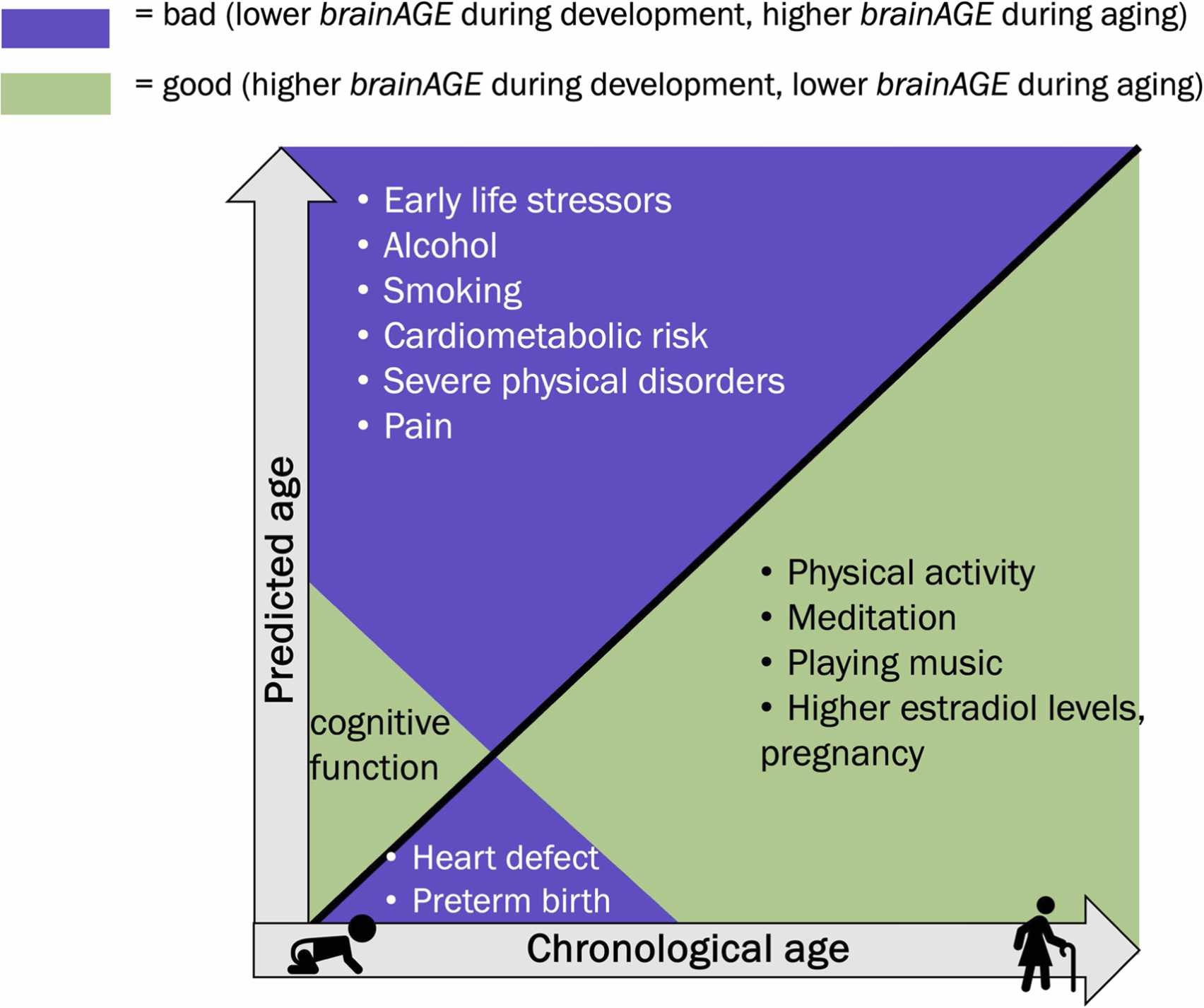 BrainAGE, brain health, and mental disorders: A systematic reviewJohanna Seitz-Holland, Shalaila S Haas, Nora Penzel, and 2 more authorsNeuroscience & Biobehavioral Reviews, Apr 2024
BrainAGE, brain health, and mental disorders: A systematic reviewJohanna Seitz-Holland, Shalaila S Haas, Nora Penzel, and 2 more authorsNeuroscience & Biobehavioral Reviews, Apr 2024The imaging-based method of brainAGE aims to characterize an individual’s vulnerability to age-related brain changes. The present study systematically reviewed brainAGE findings in neuropsychiatric conditions and discussed the potential of brainAGE as a marker for biological age. A systematic PubMed search (from inception to March 6th, 2023) identified 273 articles. The 30 included studies compared brainAGE between neuropsychiatric and healthy groups (n≥50). We presented results qualitatively and adapted a bias risk assessment questionnaire. The imaging modalities, design, and input features varied considerably between studies. While the studies found higher brainAGE in neuropsychiatric conditions (11 mild cognitive impairment/ dementia, 11 schizophrenia spectrum/ other psychotic and bipolar disorder, six depression/ anxiety, two multiple groups), the associations with clinical characteristics were mixed. While brainAGE is sensitive to group differences, limitations include the lack of diverse training samples, multi-modal studies, and external validation. Only a few studies obtained longitudinal data, and all have used algorithms built solely to predict chronological age. These limitations impede the validity of brainAGE as a biological age marker.
@article{seitz2024brainage, title = {BrainAGE, brain health, and mental disorders: A systematic review}, author = {Seitz-Holland, Johanna and Haas, Shalaila S and Penzel, Nora and Reichenberg, Abraham and Pasternak, Ofer}, journal = {Neuroscience \& Biobehavioral Reviews}, pages = {105581}, month = apr, year = {2024}, publisher = {Elsevier}, } -
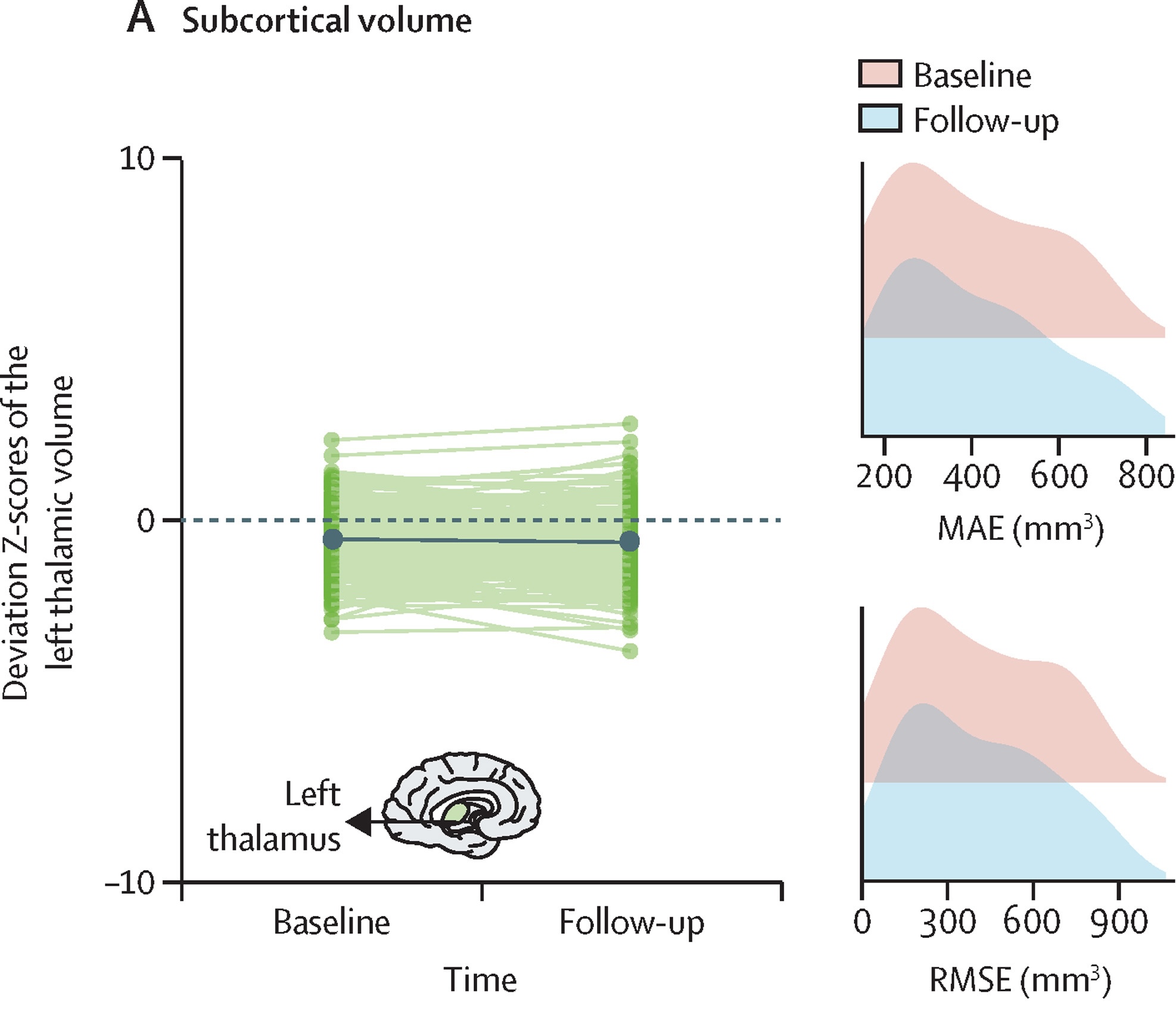 Normative modelling of brain morphometry across the lifespan with CentileBrain: algorithm benchmarking and model optimisationRuiyang Ge, Yuetong Yu, Yi Xuan Qi, and 8 more authorsThe Lancet Digital Health, Mar 2024
Normative modelling of brain morphometry across the lifespan with CentileBrain: algorithm benchmarking and model optimisationRuiyang Ge, Yuetong Yu, Yi Xuan Qi, and 8 more authorsThe Lancet Digital Health, Mar 2024The value of normative models in research and clinical practice relies on their robustness and a systematic comparison of different modelling algorithms and parameters; however, this has not been done to date. We aimed to identify the optimal approach for normative modelling of brain morphometric data through systematic empirical benchmarking, by quantifying the accuracy of different algorithms and identifying parameters that optimised model performance. We developed this framework with regional morphometric data from 37 407 healthy individuals (53% female and 47% male; aged 3–90 years) from 87 datasets from Europe, Australia, the USA, South Africa, and east Asia following a comparative evaluation of eight algorithms and multiple covariate combinations pertaining to image acquisition and quality, parcellation software versions, global neuroimaging measures, and longitudinal stability. The multivariate fractional polynomial regression (MFPR) emerged as the preferred algorithm, optimised with non-linear polynomials for age and linear effects of global measures as covariates. The MFPR models showed excellent accuracy across the lifespan and within distinct age-bins and longitudinal stability over a 2-year period. The performance of all MFPR models plateaued at sample sizes exceeding 3000 study participants. This model can inform about the biological and behavioural implications of deviations from typical age-related neuroanatomical changes and support future study designs. The model and scripts described here are freely available through CentileBrain.
@article{ge2024normative, title = {Normative modelling of brain morphometry across the lifespan with CentileBrain: algorithm benchmarking and model optimisation}, author = {Ge, Ruiyang and Yu, Yuetong and Qi, Yi Xuan and Fan, Yu-nan and Chen, Shiyu and Gao, Chuntong and Haas, Shalaila S and New, Faye and Boomsma, Dorret I and Brodaty, Henry and others}, journal = {The Lancet Digital Health}, volume = {6}, number = {3}, pages = {e211--e221}, month = mar, year = {2024}, publisher = {Elsevier}, } -
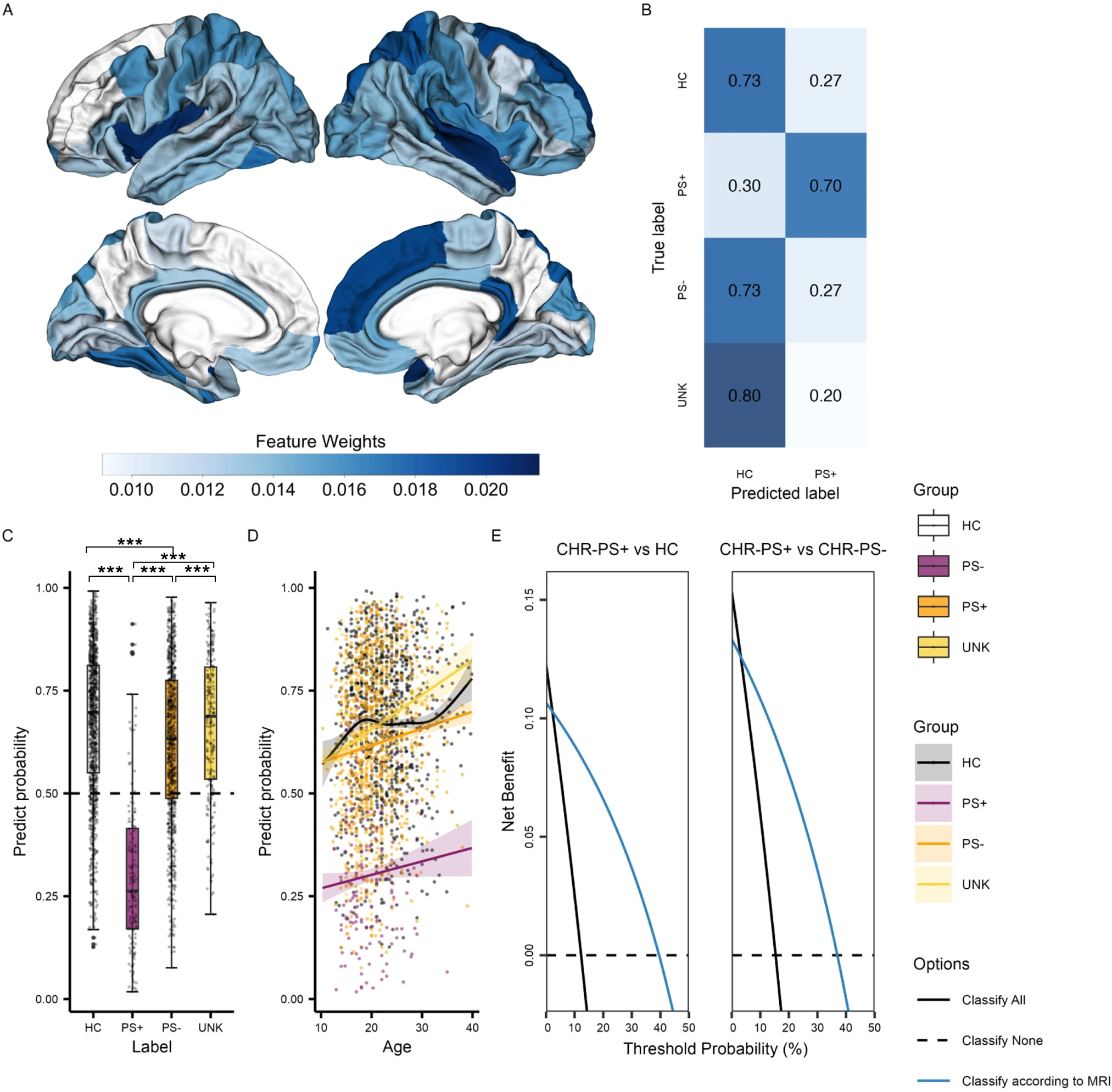 Using brain structural neuroimaging measures to predict psychosis onset for individuals at clinical high-riskYinghan Zhu, Norihide Maikusa, Joaquim Radua, and 8 more authorsMolecular psychiatry, Feb 2024
Using brain structural neuroimaging measures to predict psychosis onset for individuals at clinical high-riskYinghan Zhu, Norihide Maikusa, Joaquim Radua, and 8 more authorsMolecular psychiatry, Feb 2024Machine learning approaches using structural magnetic resonance imaging (sMRI) can be informative for disease classification, although their ability to predict psychosis is largely unknown. We created a model with individuals at CHR who developed psychosis later (CHR-PS+) from healthy controls (HCs) that can differentiate each other. We also evaluated whether we could distinguish CHR-PS+ individuals from those who did not develop psychosis later (CHR-PS-) and those with uncertain follow-up status (CHR-UNK). T1-weighted structural brain MRI scans from 1165 individuals at CHR (CHR-PS+, n = 144; CHR-PS-, n = 793; and CHR-UNK, n = 228), and 1029 HCs, were obtained from 21 sites. We used ComBat to harmonize measures of subcortical volume, cortical thickness and surface area data and corrected for non-linear effects of age and sex using a general additive model. CHR-PS+ (n = 120) and HC (n = 799) data from 20 sites served as a training dataset, which we used to build a classifier. The remaining samples were used external validation datasets to evaluate classifier performance (test, independent confirmatory, and independent group [CHR-PS- and CHR-UNK] datasets). The accuracy of the classifier on the training and independent confirmatory datasets was 85% and 73% respectively. Regional cortical surface area measures-including those from the right superior frontal, right superior temporal, and bilateral insular cortices strongly contributed to classifying CHR-PS+ from HC. CHR-PS- and CHR-UNK individuals were more likely to be classified as HC compared to CHR-PS+ (classification rate to HC: CHR-PS+, 30%; CHR-PS-, 73%; CHR-UNK, 80%). We used multisite sMRI to train a classifier to predict psychosis onset in CHR individuals, and it showed promise predicting CHR-PS+ in an independent sample. The results suggest that when considering adolescent brain development, baseline MRI scans for CHR individuals may be helpful to identify their prognosis. Future prospective studies are required about whether the classifier could be actually helpful in the clinical settings.
@article{zhu2024using, title = {Using brain structural neuroimaging measures to predict psychosis onset for individuals at clinical high-risk}, author = {Zhu, Yinghan and Maikusa, Norihide and Radua, Joaquim and S{\"a}mann, Philipp G and Fusar-Poli, Paolo and Agartz, Ingrid and Andreassen, Ole A and Bachman, Peter and Baeza, Inmaculada and Chen, Xiaogang and others}, journal = {Molecular psychiatry}, pages = {1--13}, month = feb, year = {2024}, publisher = {Nature Publishing Group UK London}, } -
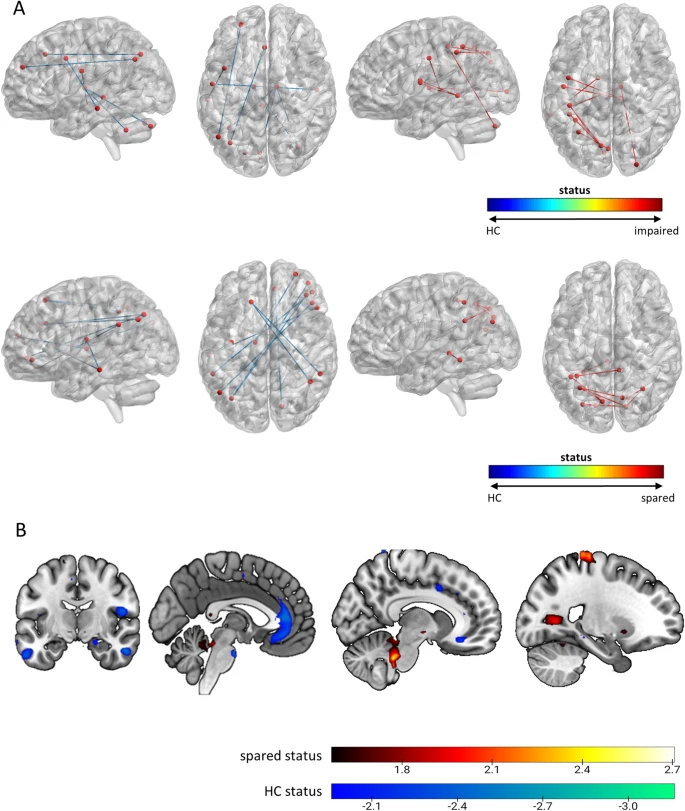 Transdiagnostic subgroups of cognitive impairment in early affective and psychotic illnessJulian Wenzel, Luzie Badde, Shalaila S Haas, and 8 more authorsNeuropsychopharmacology, Feb 2024
Transdiagnostic subgroups of cognitive impairment in early affective and psychotic illnessJulian Wenzel, Luzie Badde, Shalaila S Haas, and 8 more authorsNeuropsychopharmacology, Feb 2024Cognitively impaired and spared patient subgroups were identified in psychosis and depression, and in clinical high-risk for psychosis (CHR). Studies suggest differences in underlying brain structural and functional characteristics. It is unclear whether cognitive subgroups are transdiagnostic phenomena in early stages of psychotic and affective disorder which can be validated on the neural level. Patients with recent-onset psychosis (ROP; N = 140; female = 54), recent-onset depression (ROD; N = 130; female = 73), CHR (N = 128; female = 61) and healthy controls (HC; N = 270; female = 165) were recruited through the multi-site study PRONIA. The transdiagnostic sample and individual study groups were clustered into subgroups based on their performance in eight cognitive domains and characterized by gray matter volume (sMRI) and resting-state functional connectivity (rsFC) using support vector machine (SVM) classification. We identified an impaired subgroup (NROP = 79, NROD = 30, NCHR = 37) showing cognitive impairment in executive functioning, working memory, processing speed and verbal learning (all p < 0.001). A spared subgroup (NROP = 61, NROD = 100, NCHR = 91) performed comparable to HC. Single-disease subgroups indicated that cognitive impairment is stronger pronounced in impaired ROP compared to impaired ROD and CHR. Subgroups in ROP and ROD showed specific symptom- and functioning-patterns. rsFC showed superior accuracy compared to sMRI in differentiating transdiagnostic subgroups from HC (BACimpaired = 58.5%; BACspared = 61.7%, both: p < 0.01). Cognitive findings were validated in the PRONIA replication sample (N = 409). Individual cognitive subgroups in ROP, ROD and CHR are more informative than transdiagnostic subgroups as they map onto individual cognitive impairment and specific functioning- and symptom-patterns which show limited overlap in sMRI and rsFC.
@article{wenzel2024transdiagnostic, title = {Transdiagnostic subgroups of cognitive impairment in early affective and psychotic illness}, author = {Wenzel, Julian and Badde, Luzie and Haas, Shalaila S and Bonivento, Carolina and Van Rheenen, Tamsyn E and Antonucci, Linda A and Ruef, Anne and Penzel, Nora and Rosen, Marlene and Lichtenstein, Theresa and others}, journal = {Neuropsychopharmacology}, volume = {49}, number = {3}, pages = {573--583}, month = feb, year = {2024}, publisher = {Springer International Publishing Cham}, } -
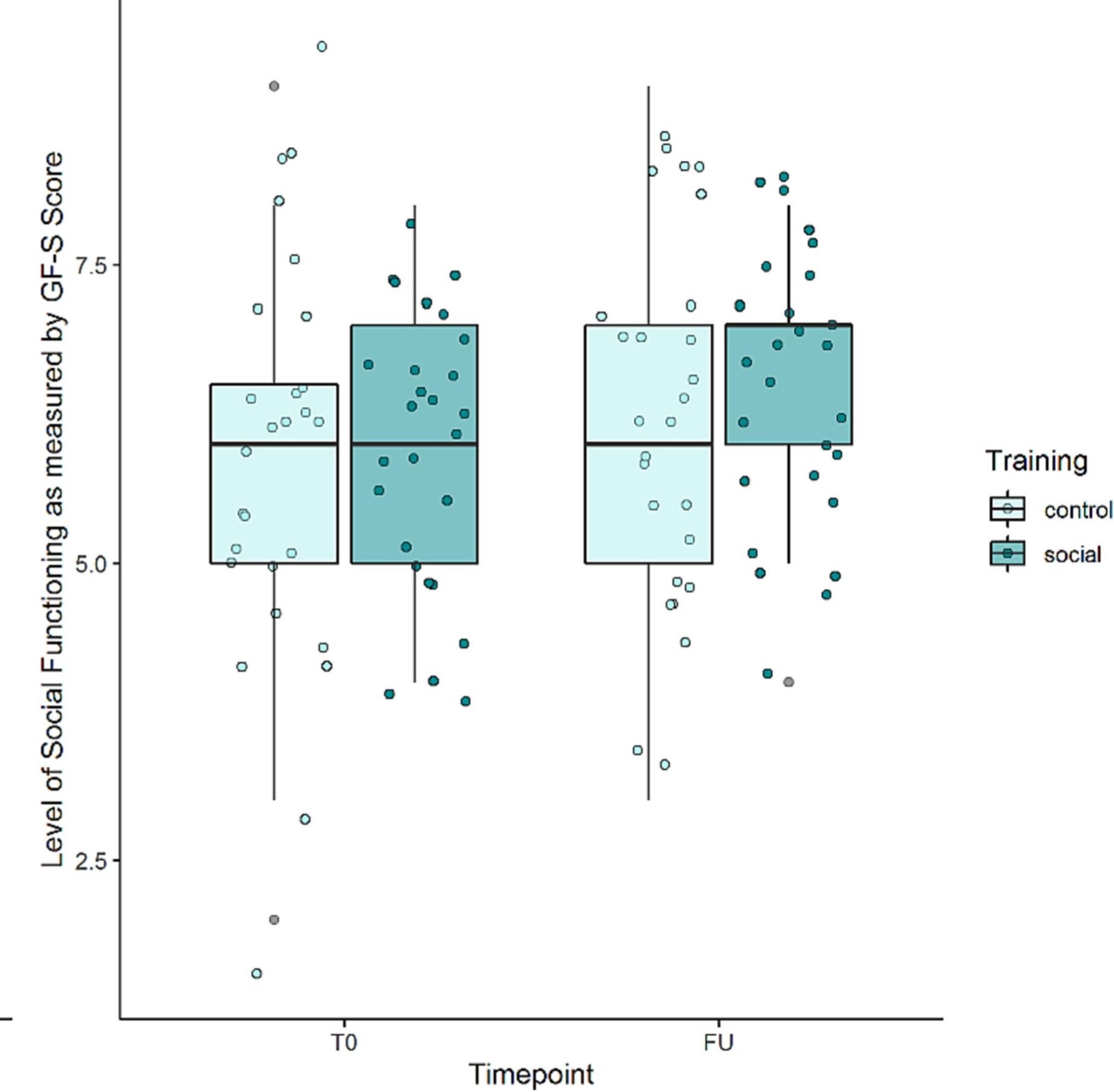 A multivariate cognitive approach to predict social functioning in recent onset psychosis in response to computerized cognitive trainingNina Walter, Julian Wenzel, Shalaila S Haas, and 8 more authorsProgress in Neuro-Psychopharmacology and Biological Psychiatry, Jan 2024
A multivariate cognitive approach to predict social functioning in recent onset psychosis in response to computerized cognitive trainingNina Walter, Julian Wenzel, Shalaila S Haas, and 8 more authorsProgress in Neuro-Psychopharmacology and Biological Psychiatry, Jan 2024Clinical and neuroimaging data has been increasingly used in recent years to disentangle heterogeneity of treatment response to cognitive training (CT) and predict which individuals may achieve the highest benefits. CT has small to medium effects on improving cognitive and social functioning in recent onset psychosis (ROP) patients, who show the most profound cognitive and social functioning deficits among psychiatric patients. We employed multivariate pattern analysis (MVPA) to investigate the potential of cognitive data to predict social functioning improvement in response to 10 h of CT in patients with ROP. A support vector machine (SVM) classifier was trained on the naturalistic data of the Personalized Prognostic Tools for Early Psychosis Management (PRONIA) study sample to predict functioning in an independent sample of 70 ROP patients using baseline cognitive data. PRONIA is a part of a FP7 EU grant program that involved 7 sites across 5 European countries, designed and conducted with the main aim of identifying (bio)markers associated with an enhanced risk of developing psychosis in order to improve early detection and prognosis. Social functioning was predicted with a balanced accuracy (BAC) of 66.4% (Sensitivity 78.8%; Specificity 54.1%; PPV 60.5%; NPV 74.1%; AUC 0.64; P = 0.01). The most frequently selected cognitive features (mean feature weights > ± 0.2) included the (1) correct number of symbol matchings within the Digit Symbol Substitution Test, (2) the number of distracting stimuli leading to an error within 300 and 200 trials in the Continuous Performance Test and (3) the dynamics of verbal fluency between 15 and 30 s within the Verbal Fluency Test, phonetic part. Next, the SVM classifier generated on the PRONIA sample was applied to the intervention sample, that obtained 54 ROP patients who were randomly assigned to a social cognitive training (SCT) or treatment as usual (TAU) group and dichotomized into good (GF-S ≥ 7) and poor (GF-S < 7) functioning patients based on their level of Global Functioning-Social (GF-S) score at follow-up (FU). By applying the initial PRONIA classifier, using out-of-sample cross-validation (OOCV) to the sample of ROP patients who have undergone the CT intervention, a BAC of 59.3% (Sensitivity 70.4%; Specificity 48.1%; PPV 57.6%; NPV 61.9%; AUC 0.63) was achieved at T0 and a BAC of 64.8% (Sensitivity 66.7%; Specificity 63.0%; PPV 64.3%; NPV 65.4%; AUC 0.66) at FU. After SCT intervention, a significant improvement in predicted social functioning values was observed in the SCT compared to TAU group (P ≤0.05; ES[Cohens’ d] = 0.18). Due to a small sample size and modest variance of social functioning of the intervention sample it was not feasible to predict individual response to SCT in the current study. Our findings suggest that the use of baseline cognitive data could provide a robust individual estimate of future social functioning, while prediction of individual response to SCT using cognitive data that can be generated in the routine patient care remains to be addressed in large-scale cognitive training trials.
@article{walter2024multivariate, title = {A multivariate cognitive approach to predict social functioning in recent onset psychosis in response to computerized cognitive training}, author = {Walter, Nina and Wenzel, Julian and Haas, Shalaila S and Squarcina, Letizia and Bonivento, Carolina and Ruef, Anne and Dwyer, Dominic and Lichtenstein, Theresa and Bastr{\"u}k, {\"O}znur and Stainton, Alexandra and others}, journal = {Progress in Neuro-Psychopharmacology and Biological Psychiatry}, volume = {128}, pages = {110864}, month = jan, year = {2024}, publisher = {Elsevier}, } - ENIGMA Brain Morphometry in CHR-P—Risk Enrichment and Antipsychotics—ReplySophia Frangou, and Shalaila S HaasJAMA psychiatry, Feb 2024
@article{frangou2024enigma, title = {ENIGMA Brain Morphometry in CHR-P—Risk Enrichment and Antipsychotics—Reply}, author = {Frangou, Sophia and Haas, Shalaila S}, journal = {JAMA psychiatry}, volume = {81}, number = {4}, pages = {428--428}, month = feb, year = {2024}, publisher = {American Medical Association}, }
2023
-
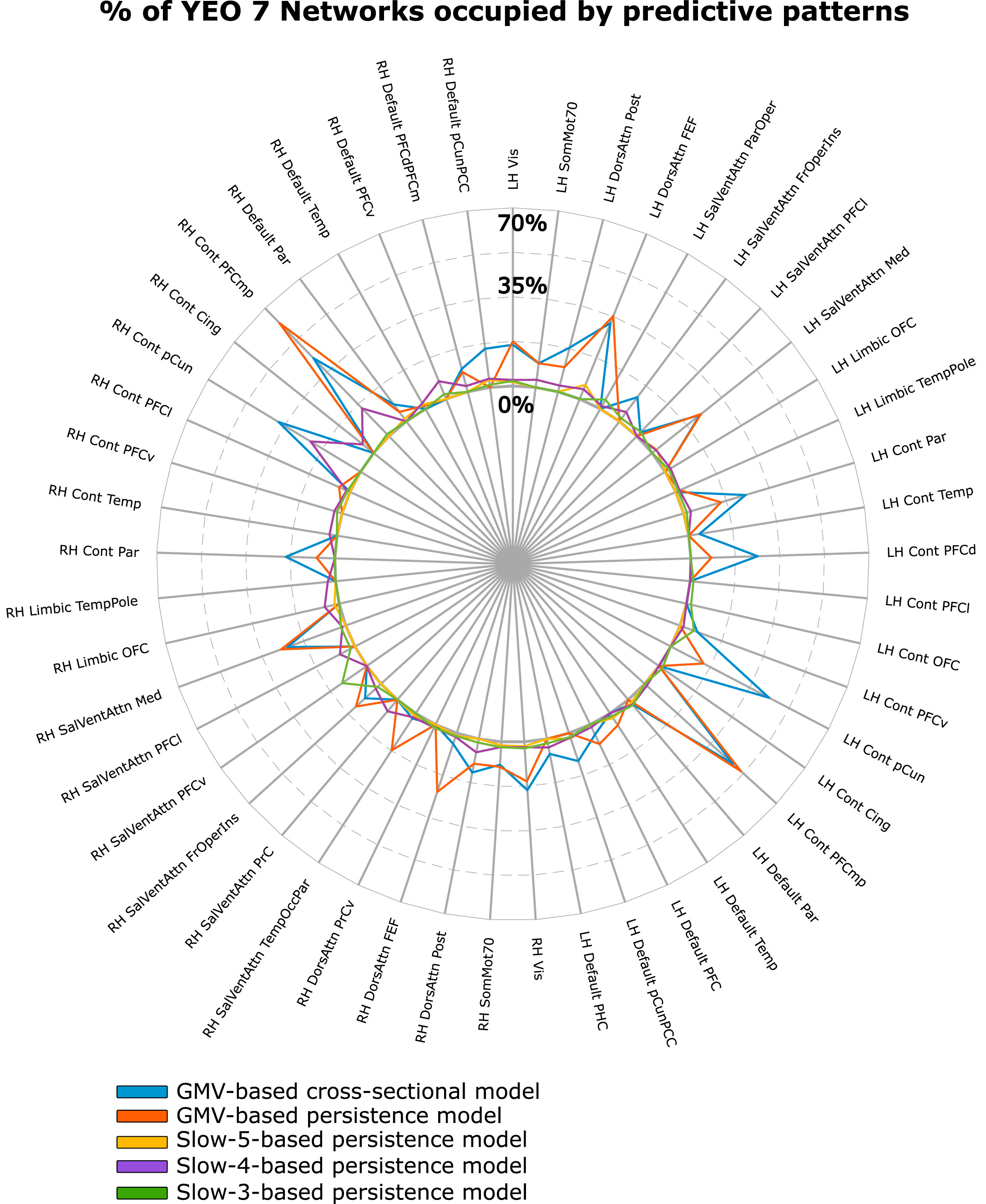 Structural and functional brain patterns predict formal thought disorder’s severity and its persistence in recent-onset psychosis: Results from the PRONIA StudyMadalina-Octavia Buciuman, Oemer Faruk Oeztuerk, David Popovic, and 8 more authorsBiological Psychiatry: Cognitive Neuroscience and Neuroimaging, Dec 2023
Structural and functional brain patterns predict formal thought disorder’s severity and its persistence in recent-onset psychosis: Results from the PRONIA StudyMadalina-Octavia Buciuman, Oemer Faruk Oeztuerk, David Popovic, and 8 more authorsBiological Psychiatry: Cognitive Neuroscience and Neuroimaging, Dec 2023Background Formal thought disorder (FThD) is a core feature of psychosis, and its severity and long-term persistence relates to poor clinical outcomes. However, advances in developing early recognition and management tools for FThD are hindered by a lack of insight into the brain-level predictors of FThD states and progression at the individual level. Methods Two hundred thirty-three individuals with recent-onset psychosis were drawn from the multisite European Prognostic Tools for Early Psychosis Management study. Support vector machine classifiers were trained within a cross-validation framework to separate two FThD symptom-based subgroups (high vs. low FThD severity), using cross-sectional whole-brain multiband fractional amplitude of low frequency fluctuations, gray matter volume and white matter volume data. Moreover, we trained machine learning models on these neuroimaging readouts to predict the persistence of high FThD subgroup membership from baseline to 1-year follow-up. Results Cross-sectionally, multivariate patterns of gray matter volume within the salience, dorsal attention, visual, and ventral attention networks separated the FThD severity subgroups (balanced accuracy [BAC] = 60.8%). Longitudinally, distributed activations/deactivations within all fractional amplitude of low frequency fluctuation sub-bands (BACslow-5 = 73.2%, BACslow-4 = 72.9%, BACslow-3 = 68.0%), gray matter volume patterns overlapping with the cross-sectional ones (BAC = 62.7%), and smaller frontal white matter volume (BAC = 73.1%) predicted the persistence of high FThD severity from baseline to follow-up, with a combined multimodal balanced accuracy of BAC = 77%. Conclusions We report the first evidence of brain structural and functional patterns predictive of FThD severity and persistence in early psychosis. These findings open up avenues for the development of neuroimaging-based diagnostic, prognostic, and treatment options for the early recognition and management of FThD and associated poor outcomes.
@article{buciuman2023structural, title = {Structural and functional brain patterns predict formal thought disorder’s severity and its persistence in recent-onset psychosis: Results from the PRONIA Study}, author = {Buciuman, Madalina-Octavia and Oeztuerk, Oemer Faruk and Popovic, David and Enrico, Paolo and Ruef, Anne and Bieler, Nadia and Sarisik, Elif and Weiske, Johanna and Dong, Mark Sen and Dwyer, Dominic B and others}, journal = {Biological Psychiatry: Cognitive Neuroscience and Neuroimaging}, volume = {8}, number = {12}, pages = {1207--1217}, month = dec, year = {2023}, publisher = {Elsevier}, } -
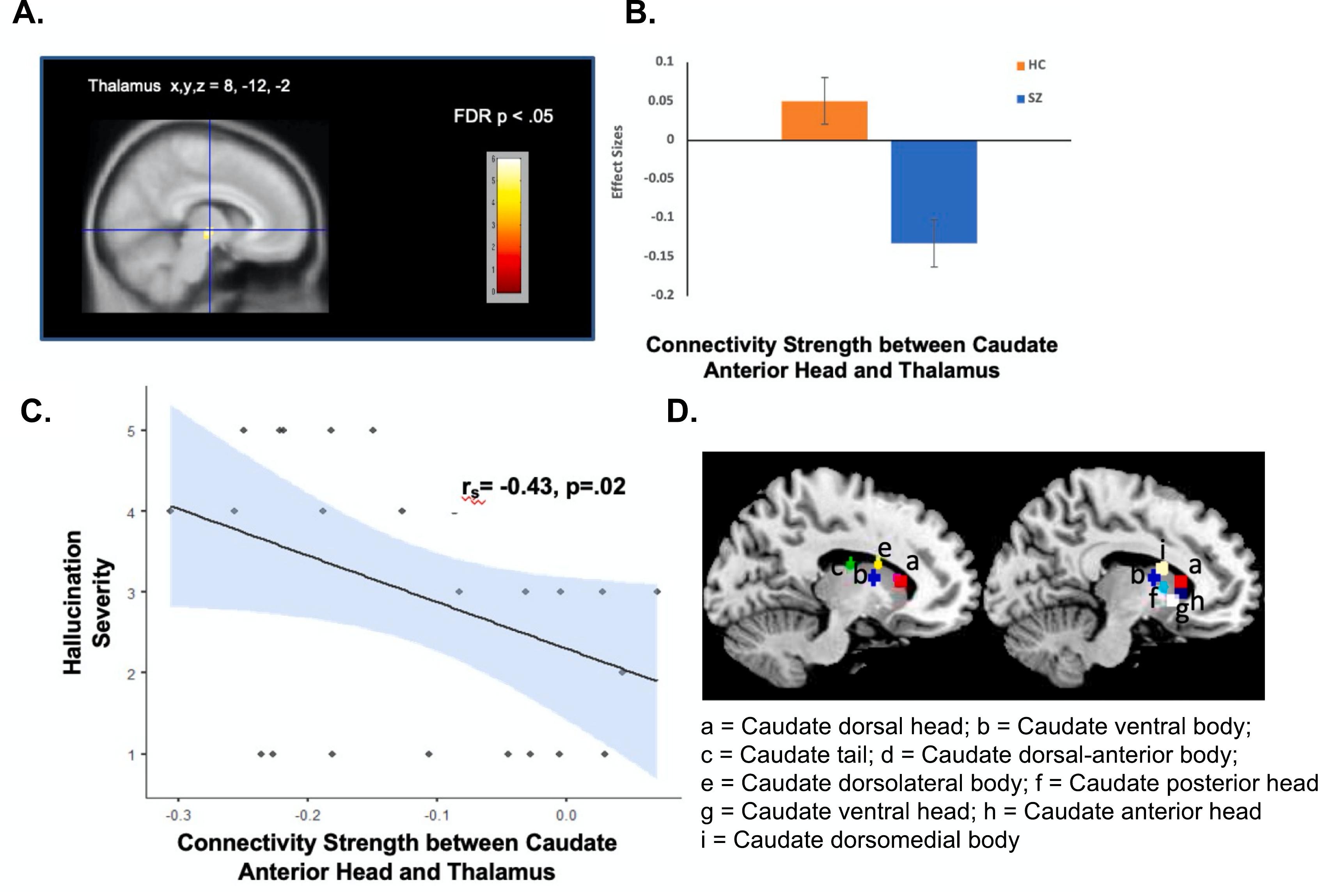 Reduced neural connectivity in the caudate anterior head predicts hallucination severity in schizophreniaLeighton BN Hinkley, Shalaila S Haas, Steven W Cheung, and 2 more authorsSchizophrenia research, Nov 2023
Reduced neural connectivity in the caudate anterior head predicts hallucination severity in schizophreniaLeighton BN Hinkley, Shalaila S Haas, Steven W Cheung, and 2 more authorsSchizophrenia research, Nov 2023Background Caudate functional abnormalities have been identified as one critical neural substrate underlying sensory gating impairments that lead to auditory phantom hallucinations in both patients with schizophrenia (SZ) and tinnitus, characterized by the perception of internally generated sounds in the absence of external environmental auditory stimuli. In this study, we tested the hypothesis as to whether functional connectivity abnormalities in distinct caudate subdivisions implicated in sensory gating and auditory phantom percepts in tinnitus, which are currently being localized for neuromodulation targeting using deep brain stimulation techniques, would be associated with auditory phantom hallucination severity in SZ. Methods Twenty five SZ and twenty eight demographically-matched healthy control (HC) participants, completed this fMRI resting-state study and clinical assessments. Results Between-group seed-to-voxel analyses revealed only one region, the caudate anterior head, which showed reduced functional connectivity with the thalamus that survived whole-brain multiple comparison corrections. Importantly, connectivity between the caudate anterior head with thalamus negatively correlated with hallucination severity. Conclusions In the present study, we deliver the first evidence of caudate subdivision specificity for the neural pathophysiology underlying hallucinations in schizophrenia within a sensory gating framework that has been developed for auditory phantoms in patients with tinnitus. Our findings provide transdiagnostic convergent evidence for the role of the caudate in the gating of auditory phantom hallucinations, observed across patients with SZ and tinnitus by specifying the anterior caudate division is key to mediation of hallucinations, and creating a path towards personalized treatment approaches to arrest auditory phantom hallucinations from reaching perceptual awareness.
@article{hinkley2023reduced, title = {Reduced neural connectivity in the caudate anterior head predicts hallucination severity in schizophrenia}, author = {Hinkley, Leighton BN and Haas, Shalaila S and Cheung, Steven W and Nagarajan, Srikantan S and Subramaniam, Karuna}, journal = {Schizophrenia research}, volume = {261}, pages = {1--5}, month = nov, year = {2023}, publisher = {Elsevier}, } -
 Normative modeling of brain morphometry in Clinical High-Risk for PsychosisShalaila S Haas, Ruiyang Ge, Ingrid Agartz, and 76 more authorsJAMA Psychiatry, Oct 2023
Normative modeling of brain morphometry in Clinical High-Risk for PsychosisShalaila S Haas, Ruiyang Ge, Ingrid Agartz, and 76 more authorsJAMA Psychiatry, Oct 2023Importance The lack of robust neuroanatomical markers of psychosis risk has been traditionally attributed to heterogeneity. A complementary hypothesis is that variation in neuroanatomical measures in individuals at psychosis risk may be nested within the range observed in healthy individuals. Objective To quantify deviations from the normative range of neuroanatomical variation in individuals at clinical high risk for psychosis (CHR-P) and evaluate their overlap with healthy variation and their association with positive symptoms, cognition, and conversion to a psychotic disorder. Design, Setting, and Participants This case-control study used clinical-, IQ-, and neuroimaging software (FreeSurfer)–derived regional measures of cortical thickness (CT), cortical surface area (SA), and subcortical volume (SV) from 1340 individuals with CHR-P and 1237 healthy individuals pooled from 29 international sites participating in the Enhancing Neuroimaging Genetics Through Meta-analysis (ENIGMA) Clinical High Risk for Psychosis Working Group. Healthy individuals and individuals with CHR-P were matched on age and sex within each recruitment site. Data were analyzed between September 1, 2021, and November 30, 2022. Main Outcomes and Measures For each regional morphometric measure, deviation scores were computed as z scores indexing the degree of deviation from their normative means from a healthy reference population. Average deviation scores (ADS) were also calculated for regional CT, SA, and SV measures and globally across all measures. Regression analyses quantified the association of deviation scores with clinical severity and cognition, and 2-proportion z tests identified case-control differences in the proportion of individuals with infranormal (z < −1.96) or supranormal (z > 1.96) scores. Results Among 1340 individuals with CHR-P, 709 (52.91%) were male, and the mean (SD) age was 20.75 (4.74) years. Among 1237 healthy individuals, 684 (55.30%) were male, and the mean (SD) age was 22.32 (4.95) years. Individuals with CHR-P and healthy individuals overlapped in the distributions of the observed values, regional z scores, and all ADS values. For any given region, the proportion of individuals with CHR-P who had infranormal or supranormal values was low (up to 153 individuals [<11.42%]) and similar to that of healthy individuals (<115 individuals [<9.30%]). Individuals with CHR-P who converted to a psychotic disorder had a higher percentage of infranormal values in temporal regions compared with those who did not convert (7.01% vs 1.38%) and healthy individuals (5.10% vs 0.89%). In the CHR-P group, only the ADS SA was associated with positive symptoms (β = −0.08; 95% CI, −0.13 to −0.02; P = .02 for false discovery rate) and IQ (β = 0.09; 95% CI, 0.02-0.15; P = .02 for false discovery rate). Conclusions and Relevance In this case-control study, findings suggest that macroscale neuromorphometric measures may not provide an adequate explanation of psychosis risk.
@article{haas_normative_2023, title = {Normative modeling of brain morphometry in Clinical High-Risk for Psychosis}, doi = {10.1001/jamapsychiatry.2023.3850}, journal = {JAMA Psychiatry}, author = {Haas, Shalaila S and Ge, Ruiyang and Agartz, Ingrid and Amminger, G. Paul and Andreassen, Ole A and Bachman, Peter and Baeza, Inmaculada and Choi, Sunah and Colibazzi, Tiziano and Cropley, Vanessa L and de la Fuente-Sandoval, Camilo and Ebdrup, Bjørn H and Fortea, Adriana and Fusar-Poli, Paolo and Glenthøj, Birte Yding and Glenthøj, Louise Birkedal and Haut, Kristen M and Hayes, Rebecca A and Heekeren, Karsten and Hooker, Christine I and Hwang, Wu Jeong and Jahanshad, Neda and Kaess, Michael and Kasai, Kiyoto and Katagiri, Naoyuki and Kim, Minah and Kindler, Jochen and Koike, Shinsuke and Kristensen, Tina D and Kwon, Jun Soo and Lawrie, Stephen M and Lee, Jimmy and Lemmers-Jansen, Imke LJ and Lin, Ashleigh and Ma, Xiaoqian and Mathalon, Daniel H and McGuire, Philip and Michel, Chantal and Mizrahi, Romina and Mizuno, Masafumi and Møller, Paul and Mora-Durán, Ricardo and Nelson, Barnaby and Nemoto, Takahiro and Nordentoft, Merete and Nordholm, Dorte and Omelchenko, Maria A and Pantelis, Christos and Pariente, Jose C and Raghava, Jayachandra M and Reyes-Madrigal, Francisco and Røssberg, Jan I and Rössler, Wulf and Salisbury, Dean F and Sasabayashi, Daiki and Schall, Ulrich and Smigielski, Lukasz and Sugranyes, Gisela and Suzuki, Michio and Takahashi, Tsutomu and Tamnes, Christian K and Theodoridou, Anastasia and Thomopoulos, Sophia I and Thompson, Paul M and Tomyshev, Alexander S and Uhlhaas, Peter J and Værnes, Tor G and van Amelsvoort, Therese AMJ and van Erp, Theo GM and Waltz, James A and Wenneberg, Christina and Westlye, Lars T and Wood, Stephen J and Zhou, Juan H and Hernaus, Dennis and Jalbrzikowski, Maria and Kahn, René S and Corcoran, Cheryl M and Frangou, Sophia}, month = oct, year = {2023}, pages = {2023.01.17.523348}, } -
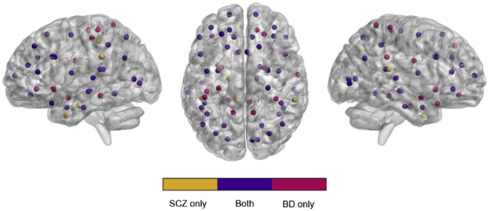 Functional brain imaging in early-onset psychosisMathilde Antoniades, Shalaila S Haas, Shirine Moukaled, and 3 more authorsIn Adolescent Psychosis, Oct 2023
Functional brain imaging in early-onset psychosisMathilde Antoniades, Shalaila S Haas, Shirine Moukaled, and 3 more authorsIn Adolescent Psychosis, Oct 2023This chapter focuses on task and resting-state functional magnetic resonance imaging in children and adolescents with early-onset psychosis, or at clinical or familial risk for psychosis. Following a systematic review of the literature published in the last decade, we identified 105 relevant articles. The results showed marked interstudy variation and were dominated by small scale cross-sectional studies. The general pattern that emerged suggested: (a) abnormalities in frontoparietal activation during cognitive systems tasks, indicating deficient activation in youth with early-onset schizophrenia and inefficient activation in those at risk for schizophrenia; (b) hyperactivation in “emotional” processing regions in youth with early-onset bipolar disorder and those at risk for bipolar disorder; (c) widespread regional resting-state dysconnectivity across youth with established diagnoses and in those at risk for bipolar disorder or schizophrenia. Larger and longitudinal studies are required to evaluate conclusively the functional neuroimaging signature of early-onset psychosis.
@incollection{antoniades2023functional, title = {Functional brain imaging in early-onset psychosis}, author = {Antoniades, Mathilde and Haas, Shalaila S and Moukaled, Shirine and New, Faye and Pescatore, Samantha D and Frangou, Sophia}, booktitle = {Adolescent Psychosis}, pages = {205--241}, year = {2023}, publisher = {Elsevier}, }
2022
-
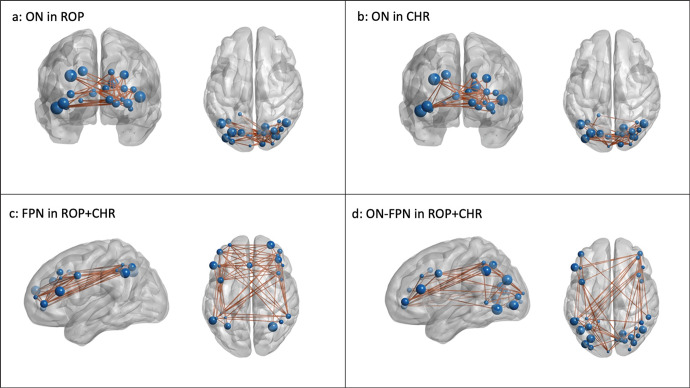 The impact of visual dysfunctions in recent-onset psychosis and clinical high-risk state for psychosisJohanna M Schwarzer, Inga Meyhoefer, Linda A Antonucci, and 8 more authorsNeuropsychopharmacology, Aug 2022
The impact of visual dysfunctions in recent-onset psychosis and clinical high-risk state for psychosisJohanna M Schwarzer, Inga Meyhoefer, Linda A Antonucci, and 8 more authorsNeuropsychopharmacology, Aug 2022Subtle subjective visual dysfunctions (VisDys) are reported by about 50% of patients with schizophrenia and are suggested to predict psychosis states. Deeper insight into VisDys, particularly in early psychosis states, could foster the understanding of basic disease mechanisms mediating susceptibility to psychosis, and thereby inform preventive interventions. We systematically investigated the relationship between VisDys and core clinical measures across three early phase psychiatric conditions. Second, we used a novel multivariate pattern analysis approach to predict VisDys by resting-state functional connectivity within relevant brain systems. VisDys assessed with the Schizophrenia Proneness Instrument (SPI-A), clinical measures, and resting-state fMRI data were examined in recent-onset psychosis (ROP, n = 147), clinical high-risk states of psychosis (CHR, n = 143), recent-onset depression (ROD, n = 151), and healthy controls (HC, n = 280). Our multivariate pattern analysis approach used pairwise functional connectivity within occipital (ON) and frontoparietal (FPN) networks implicated in visual information processing to predict VisDys. VisDys were reported more often in ROP (50.34%), and CHR (55.94%) than in ROD (16.56%), and HC (4.28%). Higher severity of VisDys was associated with less functional remission in both CHR and ROP, and, in CHR specifically, lower quality of life (Qol), higher depressiveness, and more severe impairment of visuospatial constructability. ON functional connectivity predicted presence of VisDys in ROP (balanced accuracy 60.17%, p = 0.0001) and CHR (67.38%, p = 0.029), while in the combined ROP + CHR sample VisDys were predicted by FPN (61.11%, p = 0.006). These large-sample study findings suggest that VisDys are clinically highly relevant not only in ROP but especially in CHR, being closely related to aspects of functional outcome, depressiveness, and Qol. Findings from multivariate pattern analysis support a model of functional integrity within ON and FPN driving the VisDys phenomenon and being implicated in core disease mechanisms of early psychosis states.
@article{schwarzer2022impact, title = {The impact of visual dysfunctions in recent-onset psychosis and clinical high-risk state for psychosis}, author = {Schwarzer, Johanna M and Meyhoefer, Inga and Antonucci, Linda A and Kambeitz-Ilankovic, Lana and Surmann, Marian and Bienek, Olga and Romer, Georg and Dannlowski, Udo and Hahn, Tim and Korda, Alexandra and others}, journal = {Neuropsychopharmacology}, volume = {47}, number = {12}, pages = {2051--2060}, year = {2022}, month = aug, publisher = {Nature Publishing Group}, } -
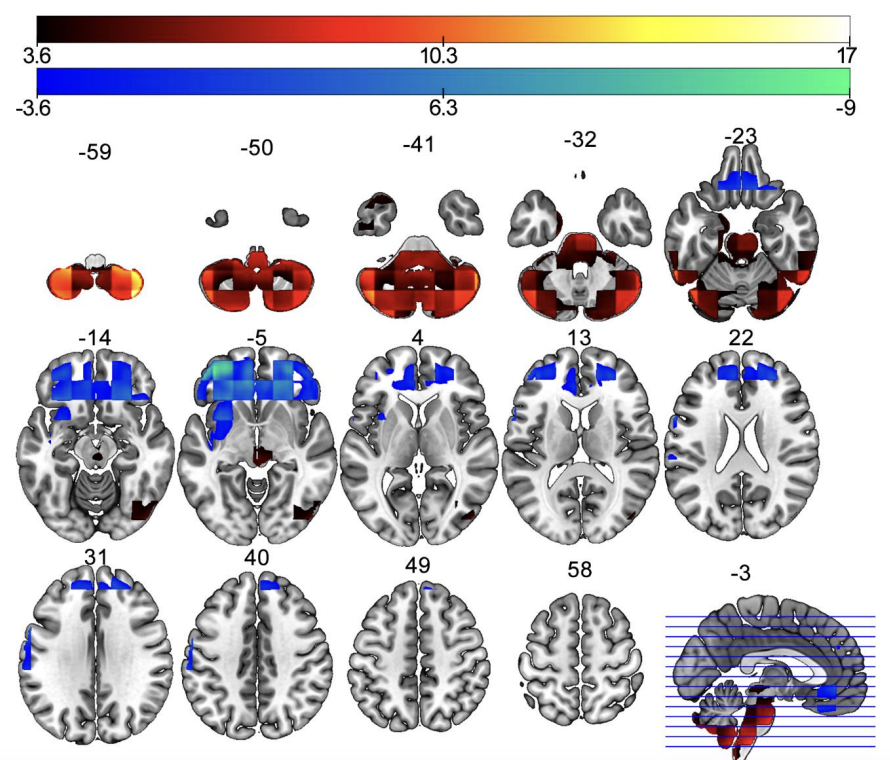 Sex differences in predictors and regional patterns of brain age gap estimatesNicole Sanford, Ruiyang Ge, Mathilde Antoniades, and 7 more authorsHuman Brain Mapping, Oct 2022
Sex differences in predictors and regional patterns of brain age gap estimatesNicole Sanford, Ruiyang Ge, Mathilde Antoniades, and 7 more authorsHuman Brain Mapping, Oct 2022Abstract The brain-age-gap estimate (brainAGE) quantifies the difference between chronological age and age predicted by applying machine-learning models to neuroimaging data and is considered a biomarker of brain health. Understanding sex differences in brainAGE is a significant step toward precision medicine. Global and local brainAGE (G-brainAGE and L-brainAGE, respectively) were computed by applying machine learning algorithms to brain structural magnetic resonance imaging data from 1113 healthy young adults (54.45% females; age range: 22-37 years) participating in the Human Connectome Project. Sex differences were determined in G-brainAGE and L-brainAGE. Random forest regression was used to determine sex-specific associations between G-brainAGE and non-imaging measures pertaining to sociodemographic characteristics and mental, physical, and cognitive functions. L-brainAGE showed sex-specific differences; in females, compared to males, L-brainAGE was higher in the cerebellum and brainstem and lower in the prefrontal cortex and insula. Although sex differences in G-brainAGE were minimal, associations between G-brainAGE and non-imaging measures differed between sexes with the exception of poor sleep quality, which was common to both. While univariate relationships were small, the most important predictor of higher G-brainAGE was self-identification as non-white in males and systolic blood pressure in females. The results demonstrate the value of applying sex-specific analyses and machine learning methods to advance our understanding of sex-related differences in factors that influence the rate of brain aging and provide a foundation for targeted interventions.
@article{sanford_sex_2022, title = {Sex differences in predictors and regional patterns of brain age gap estimates}, volume = {n/a}, issn = {1065-9471}, url = {https://doi.org/10.1002/hbm.25983}, doi = {10.1002/hbm.25983}, number = {n/a}, urldate = {2022-08-01}, journal = {Human Brain Mapping}, author = {Sanford, Nicole and Ge, Ruiyang and Antoniades, Mathilde and Modabbernia, Amirhossein and Haas, Shalaila S and Whalley, Heather C and Galea, Liisa and Popescu, Sebastian G and Cole, James H and Frangou, Sophia}, month = oct, year = {2022}, } -
 Neuroanatomical heterogeneity and homogeneity in individuals at clinical high risk for psychosisHelen Baldwin, Joaquim Radua, Mathilde Antoniades, and 8 more authorsTranslational psychiatry, Jul 2022
Neuroanatomical heterogeneity and homogeneity in individuals at clinical high risk for psychosisHelen Baldwin, Joaquim Radua, Mathilde Antoniades, and 8 more authorsTranslational psychiatry, Jul 2022Individuals at Clinical High Risk for Psychosis (CHR-P) demonstrate heterogeneity in clinical profiles and outcome features. However, the extent of neuroanatomical heterogeneity in the CHR-P state is largely undetermined. We aimed to quantify the neuroanatomical heterogeneity in structural magnetic resonance imaging measures of cortical surface area (SA), cortical thickness (CT), subcortical volume (SV), and intracranial volume (ICV) in CHR-P individuals compared with healthy controls (HC), and in relation to subsequent transition to a first episode of psychosis. The ENIGMA CHR-P consortium applied a harmonised analysis to neuroimaging data across 29 international sites, including 1579 CHR-P individuals and 1243 HC, offering the largest pooled CHR-P neuroimaging dataset to date. Regional heterogeneity was indexed with the Variability Ratio (VR) and Coefficient of Variation (CV) ratio applied at the group level. Personalised estimates of heterogeneity of SA, CT and SV brain profiles were indexed with the novel Person-Based Similarity Index (PBSI), with two complementary applications. First, to assess the extent of within-diagnosis similarity or divergence of neuroanatomical profiles between individuals. Second, using a normative modelling approach, to assess the ‘normativeness’ of neuroanatomical profiles in individuals at CHR-P. CHR-P individuals demonstrated no greater regional heterogeneity after applying FDR corrections. However, PBSI scores indicated significantly greater neuroanatomical divergence in global SA, CT and SV profiles in CHR-P individuals compared with HC. Normative PBSI analysis identified 11 CHR-P individuals (0.70%) with marked deviation (>1.5 SD) in SA, 118 (7.47%) in CT and 161 (10.20%) in SV. Psychosis transition was not significantly associated with any measure of heterogeneity. Overall, our examination of neuroanatomical heterogeneity within the CHR-P state indicated greater divergence in neuroanatomical profiles at an individual level, irrespective of psychosis conversion. Further large-scale investigations are required of those who demonstrate marked deviation.
@article{baldwin2022neuroanatomical, title = {Neuroanatomical heterogeneity and homogeneity in individuals at clinical high risk for psychosis}, author = {Baldwin, Helen and Radua, Joaquim and Antoniades, Mathilde and Haas, Shalaila S and Frangou, Sophia and Agartz, Ingrid and Allen, Paul and Andreassen, Ole A and Atkinson, Kimberley and Bachman, Peter and others}, journal = {Translational psychiatry}, volume = {12}, number = {1}, pages = {1--11}, year = {2022}, month = jul, publisher = {Nature Publishing Group}, } -
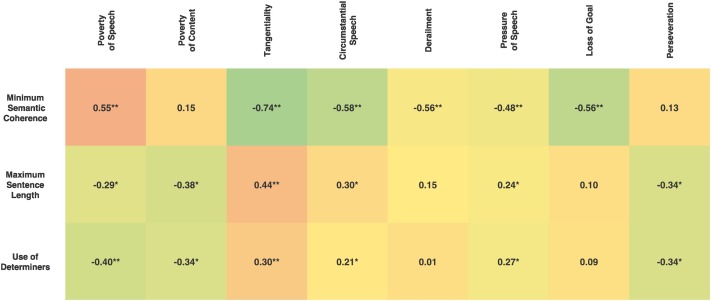 Construct validity for computational linguistic metrics in individuals at clinical risk for psychosis: Associations with clinical ratingsZarina R Bilgrami, Cansu Sarac, Agrima Srivastava, and 8 more authorsSchizophrenia Research, Jul 2022
Construct validity for computational linguistic metrics in individuals at clinical risk for psychosis: Associations with clinical ratingsZarina R Bilgrami, Cansu Sarac, Agrima Srivastava, and 8 more authorsSchizophrenia Research, Jul 2022Language deficits are prevalent in psychotic illness, including its risk states, and are related to marked impairment in functioning. It is therefore important to characterize language impairment in the psychosis spectrum in order to develop potential preventive interventions. Natural language processing (NLP) metrics of semantic coherence and syntactic complexity have been used to discriminate schizophrenia patients from healthy controls (HC) and predict psychosis onset in individuals at clinical high-risk (CHR) for psychosis. To date, no studies have yet examined the construct validity of key NLP features with respect to clinical ratings of thought disorder in a CHR cohort. Herein we test the association of key NLP metrics of coherence and complexity with ratings of positive and negative thought disorder, respectively, in 60 CHR individuals, using Andreasen’s Scale of Assessment of Thought, Language and Communication (TLC) Scale to measure of positive and negative thought disorder. As hypothesized, in CHR individuals, the NLP metric of semantic coherence was significantly correlated with positive thought disorder severity and the NLP metrics of complexity (sentence length and determiner use) were correlated with negative thought disorder severity. The finding of construct validity supports the premise that NLP analytics, at least in respect to core features of reduction of coherence and complexity, are capturing clinically relevant language disturbances in risk states for psychosis. Further psychometric study is required, in respect to reliability and other forms of validity.
@article{bilgrami2022construct, title = {Construct validity for computational linguistic metrics in individuals at clinical risk for psychosis: Associations with clinical ratings}, author = {Bilgrami, Zarina R and Sarac, Cansu and Srivastava, Agrima and Herrera, Shaynna N and Azis, Matilda and Haas, Shalaila S and Shaik, Riaz B and Parvaz, Muhammad A and Mittal, Vijay A and Cecchi, Guillermo and others}, journal = {Schizophrenia Research}, year = {2022}, month = jul, publisher = {Elsevier}, } -
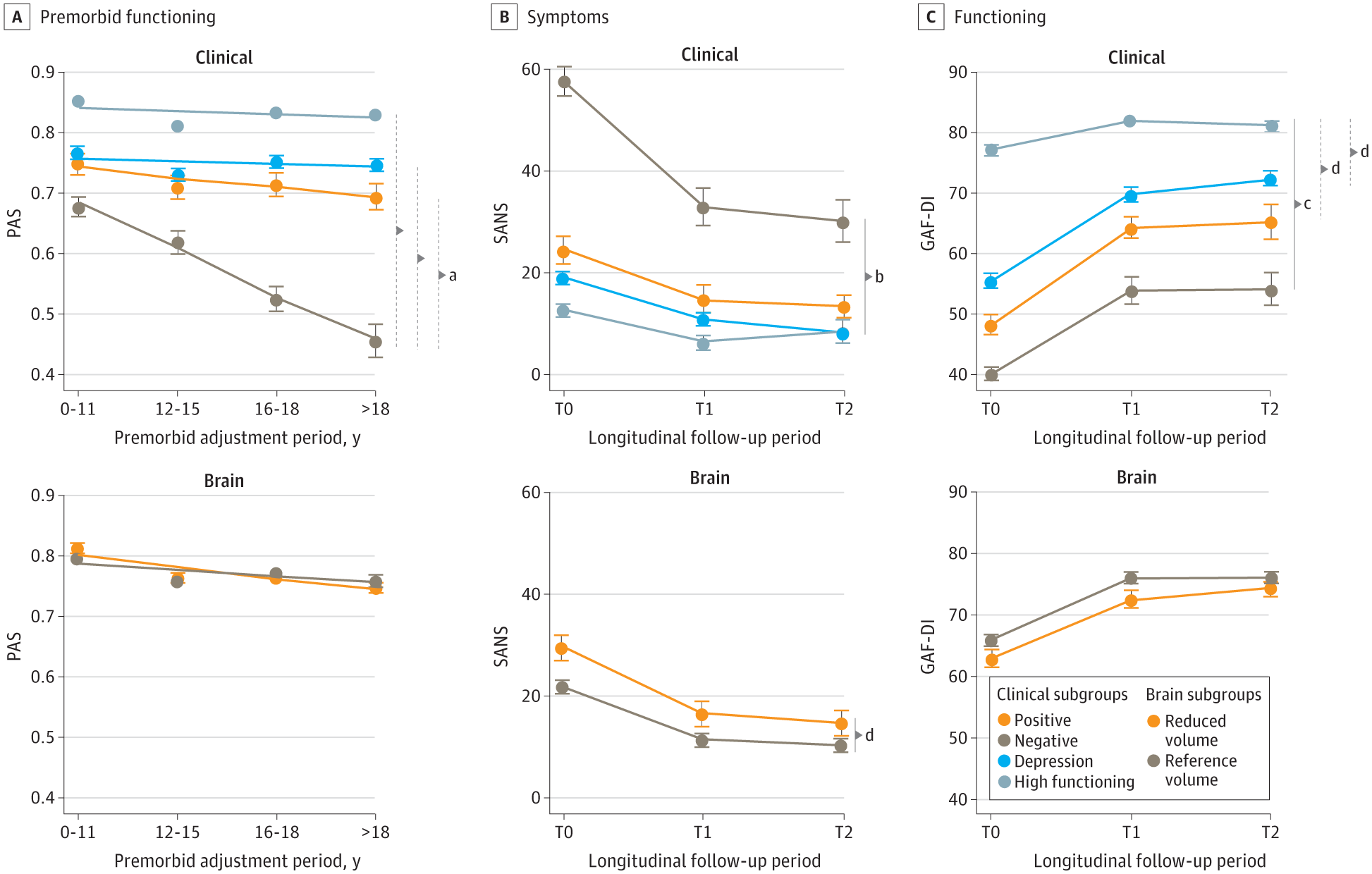 Clinical, Brain, and Multilevel Clustering in Early Psychosis and Affective StagesDominic B Dwyer, Madalina-Octavia Buciuman, Anne Ruef, and 8 more authorsJAMA psychiatry, Jul 2022
Clinical, Brain, and Multilevel Clustering in Early Psychosis and Affective StagesDominic B Dwyer, Madalina-Octavia Buciuman, Anne Ruef, and 8 more authorsJAMA psychiatry, Jul 2022Importance: Approaches are needed to stratify individuals in early psychosis stages beyond positive symptom severity to investigate specificity related to affective and normative variation and to validate solutions with premorbid, longitudinal, and genetic risk measures. Objective: To use machine learning techniques to cluster, compare, and combine subgroup solutions using clinical and brain structural imaging data from early psychosis and depression stages. Design, Setting, and Participants: A multisite, naturalistic, longitudinal cohort study (10 sites in 5 European countries; including major follow-up intervals at 9 and 18 months) with a referred patient sample of those with clinical high risk for psychosis (CHR-P), recent-onset psychosis (ROP), recent-onset depression (ROD), and healthy controls were recruited between February 1, 2014, to July 1, 2019. Data were analyzed between January 2020 and January 2022. Main Outcomes and Measures: A nonnegative matrix factorization technique separately decomposed clinical (287 variables) and parcellated brain structural volume (204 gray, white, and cerebrospinal fluid regions) data across CHR-P, ROP, ROD, and healthy controls study groups. Stability criteria determined cluster number using nested cross-validation. Validation targets were compared across subgroup solutions (premorbid, longitudinal, and schizophrenia polygenic risk scores). Multiclass supervised machine learning produced a transferable solution to the validation sample. Results: There were a total of 749 individuals in the discovery group and 610 individuals in the validation group. Individuals included those with CHR-P (n = 287), ROP (n = 323), ROD (n = 285), and healthy controls (n = 464), The mean (SD) age was 25.1 (5.9) years, and 702 (51.7%) were female. A clinical 4-dimensional solution separated individuals based on positive symptoms, negative symptoms, depression, and functioning, demonstrating associations with all validation targets. Brain clustering revealed a subgroup with distributed brain volume reductions associated with negative symptoms, reduced performance IQ, and increased schizophrenia polygenic risk scores. Multilevel results distinguished between normative and illness-related brain differences. Subgroup results were largely validated in the external sample. Conclusions and Relevance: The results of this longitudinal cohort study provide stratifications beyond the expression of positive symptoms that cut across illness stages and diagnoses. Clinical results suggest the importance of negative symptoms, depression, and functioning. Brain results suggest substantial overlap across illness stages and normative variation, which may highlight a vulnerability signature independent from specific presentations. Premorbid, longitudinal, and genetic risk validation suggested clinical importance of the subgroups to preventive treatments.
@article{dwyer2022clinical, title = {Clinical, Brain, and Multilevel Clustering in Early Psychosis and Affective Stages}, author = {Dwyer, Dominic B and Buciuman, Madalina-Octavia and Ruef, Anne and Kambeitz, Joseph and Dong, Mark Sen and Stinson, Caedyn and Kambeitz-Ilankovic, Lana and Degenhardt, Franziska and Sanfelici, Rachele and Antonucci, Linda A and others}, journal = {JAMA psychiatry}, year = {2022}, month = jul, } -
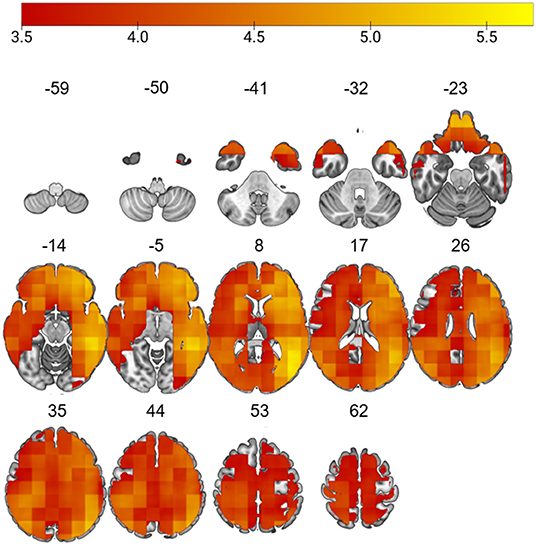 Accelerated Global and Local Brain Aging Differentiate Cognitively Impaired From Cognitively Spared Patients With SchizophreniaShalaila S Haas, Ruiyang Ge, Nicole Sanford, and 5 more authorsFrontiers in Psychiatry, Jun 2022
Accelerated Global and Local Brain Aging Differentiate Cognitively Impaired From Cognitively Spared Patients With SchizophreniaShalaila S Haas, Ruiyang Ge, Nicole Sanford, and 5 more authorsFrontiers in Psychiatry, Jun 2022Background: Accelerated aging has been proposed as a mechanism underlying the clinical and cognitive presentation of schizophrenia. The current study extends the field by examining both global and regional patterns of brain aging in schizophrenia, as inferred from brain structural data, and their association with cognitive and psychotic symptoms. Methods: Global and local brain-age-gap-estimates (G-brainAGE and L-brainAGE) were computed using a U-Net Model from T1-weighted structural neuroimaging data from 84 patients (aged 16–35 years) with early-stage schizophrenia (illness duration <5 years) and 1,169 healthy individuals (aged 16–37 years). Multidomain cognitive data from the patient sample were submitted to Heterogeneity through Discriminative Analysis (HYDRA) to identify cognitive clusters. Results: HYDRA classified patients into a cognitively impaired cluster (n = 69) and a cognitively spared cluster (n = 15). Compared to healthy individuals, G-brainAGE was significantly higher in the cognitively impaired cluster (+11.08 years) who also showed widespread elevation in L-brainAGE, with the highest deviance observed in frontal and temporal regions. The cognitively spared cluster showed a moderate increase in G-brainAGE (+8.94 years), and higher L-brainAGE localized in the anterior cingulate cortex. Psychotic symptom severity in both clusters showed a positive but non-significant association with G-brainAGE. Discussion: Accelerated aging in schizophrenia can be detected at the early disease stages and appears more closely associated with cognitive dysfunction rather than clinical symptoms. Future studies replicating our findings in multi-site cohorts with larger numbers of participants are warranted.
@article{haas2022accelerated, title = {Accelerated Global and Local Brain Aging Differentiate Cognitively Impaired From Cognitively Spared Patients With Schizophrenia}, author = {Haas, Shalaila S and Ge, Ruiyang and Sanford, Nicole and Modabbernia, Amirhossein and Reichenberg, Abraham and Whalley, Heather C and Kahn, Ren{\'e} S and Frangou, Sophia}, journal = {Frontiers in Psychiatry}, pages = {1294}, year = {2022}, month = jun, publisher = {Frontiers}, } -
 Lower functional hippocampal connectivity in healthy adults is jointly associated with higher levels of leptin and insulin resistanceShalaila S Haas, Alison Myoraku, Kathleen Watson, and 4 more authorsEuropean Psychiatry, May 2022
Lower functional hippocampal connectivity in healthy adults is jointly associated with higher levels of leptin and insulin resistanceShalaila S Haas, Alison Myoraku, Kathleen Watson, and 4 more authorsEuropean Psychiatry, May 2022Background: Metabolic dysregulation is currently considered a major risk factor for hippocampal pathology. The aim of the present study was to characterize the influence of key metabolic drivers on functional connectivity of the hippocampus in healthy adults. Methods: Insulin resistance was directly quantified by measuring steady-state plasma glucose (SSPG) concentration during the insulin suppression test and fasting levels of insulin, glucose, leptin, and cortisol, and measurements of body mass index and waist circumference were obtained in a sample of healthy cognitively intact adults (n = 104). Resting-state neuroimaging data were also acquired for the quantification of hippocampal functional cohesiveness and integration with the major resting-state networks (RSNs). Data-driven analysis using unsupervised machine learning (k-means clustering) was then employed to identify clusters of individuals based on their metabolic and functional connectivity profiles. Results: K-means clustering identified two clusters of increasing metabolic deviance evidenced by cluster differences in the plasma levels of leptin (40.36 (29.97) vs. 27.59 (25.58) μg/L) and the degree of insulin resistance (SSPG concentration: 161.63 (65.27) vs. 125.72 (66.81) mg/dL). Individuals in the cluster with higher metabolic deviance showed lower functional cohesiveness within each hippocampus and lower integration of posterior and anterior components of the left and right hippocampus with the major RSNs. The two clusters did not differ in general intellectual ability or episodic memory. Conclusions: We identified two clusters of individuals differentiated by abnormalities in insulin resistance, leptin levels, and hippocampal connectivity, with one of the clusters showing greater deviance. These findings support the link between metabolic dysregulation and hippocampal function even in nonclinical samples.
@article{haas2022lower, title = {Lower functional hippocampal connectivity in healthy adults is jointly associated with higher levels of leptin and insulin resistance}, author = {Haas, Shalaila S and Myoraku, Alison and Watson, Kathleen and Robakis, Thalia and Frangou, Sophia and Abbasi, Fahim and Rasgon, Natalie}, journal = {European Psychiatry}, volume = {65}, number = {1}, year = {2022}, month = may, publisher = {Cambridge University Press}, } -
 The clinical relevance of formal thought disorder in the early stages of psychosis: results from the PRONIA studyOemer Faruk Oeztuerk, Alessandro Pigoni, Julian Wenzel, and 8 more authorsEuropean archives of psychiatry and clinical neuroscience, Apr 2022
The clinical relevance of formal thought disorder in the early stages of psychosis: results from the PRONIA studyOemer Faruk Oeztuerk, Alessandro Pigoni, Julian Wenzel, and 8 more authorsEuropean archives of psychiatry and clinical neuroscience, Apr 2022Background: Formal thought disorder (FTD) has been associated with more severe illness courses and functional deficits in patients with psychotic disorders. However, it remains unclear whether the presence of FTD characterises a specific subgroup of patients showing more prominent illness severity, neurocognitive and functional impairments. This study aimed to identify stable and generalizable FTD-subgroups of patients with recent-onset psychosis (ROP) by applying a comprehensive data-driven clustering approach and to test the validity of these subgroups by assessing associations between this FTD-related stratification, social and occupational functioning, and neurocognition. Methods: 279 patients with ROP were recruited as part of the multi-site European PRONIA study (Personalised Prognostic Tools for Early Psychosis Management; www.pronia.eu). Five FTD-related symptoms (conceptual disorganization, poverty of content of speech, difficulty in abstract thinking, increased latency of response and poverty of speech) were assessed with Positive and Negative Symptom Scale (PANSS) and the Scale for the Assessment of Negative Symptoms (SANS). Results: The results with two patient subgroups showing different levels of FTD were the most stable and generalizable clustering solution (predicted clustering strength value = 0.86). FTD-High subgroup had lower scores in social (pfdr < 0.001) and role (pfdr < 0.001) functioning, as well as worse neurocognitive performance in semantic (pfdr < 0.001) and phonological verbal fluency (pfdr < 0.001), short-term verbal memory (pfdr = 0.002) and abstract thinking (pfdr = 0.010), in comparison to FTD-Low group. Conclusions: Clustering techniques allowed us to identify patients with more pronounced FTD showing more severe deficits in functioning and neurocognition, thus suggesting that FTD may be a relevant marker of illness severity in the early psychosis pathway.
@article{oeztuerk2022clinical, title = {The clinical relevance of formal thought disorder in the early stages of psychosis: results from the PRONIA study}, author = {Oeztuerk, Oemer Faruk and Pigoni, Alessandro and Wenzel, Julian and Haas, Shalaila S and Popovic, David and Ruef, Anne and Dwyer, Dominic B and Kambeitz-Ilankovic, Lana and Ruhrmann, Stephan and Chisholm, Katharine and others}, journal = {European archives of psychiatry and clinical neuroscience}, volume = {272}, number = {3}, pages = {403--413}, year = {2022}, month = apr, publisher = {Springer Berlin Heidelberg}, } -
 A case report and first-person account of an individual at risk for psychosis who improved during the COVID-19 pandemicShaynna N Herrera, Cansu Sarac, Zarina R Bilgrami, and 7 more authorsPsychosis, Apr 2022
A case report and first-person account of an individual at risk for psychosis who improved during the COVID-19 pandemicShaynna N Herrera, Cansu Sarac, Zarina R Bilgrami, and 7 more authorsPsychosis, Apr 2022Background: The COVID-19 pandemic is expected to increase stress and mental health symptoms. We present the case of a young man at risk for psychosis who has paradoxically shown symptomatic and functional improvement as a result of circumstances produced by COVID-19. These changes were unexpected given the client’s persistent mental health struggles in the year leading up to the COVID-19 outbreak in the United States and the expectation of an exacerbation of psychotic-like symptoms. Methods: This report is based on clinical assessments and the client’s first-person account during the height of the pandemic when stay at home orders were in place. Results: During the pandemic, the client demonstrated increased agency by taking on more responsibility at home and obtaining part-time employment. He showed improvement in his mood and relationships with others, had less symptom-related distress, and significantly reduced his cannabis use. The client interpreted these improvements in terms of changing his mindset toward more adaptive thoughts and engaging in healthy coping skills such as praying, reading, and healthy eating. Discussion: This case highlights the importance of fostering agency in clients during a time of crisis and ensuring that clinicians be aware of potential biases about mental health symptom exacerbation.
@article{herrera2022case, title = {A case report and first-person account of an individual at risk for psychosis who improved during the COVID-19 pandemic}, author = {Herrera, Shaynna N and Sarac, Cansu and Bilgrami, Zarina R and Dobbs, Matthew F and Jespersen, Rachel and Haas, Shalaila S and Garg, Sahil and Shaik, Riaz B and Landa, Yulia and Corcoran, Cheryl M}, journal = {Psychosis}, volume = {14}, number = {2}, pages = {190--199}, year = {2022}, month = apr, publisher = {Routledge}, } -
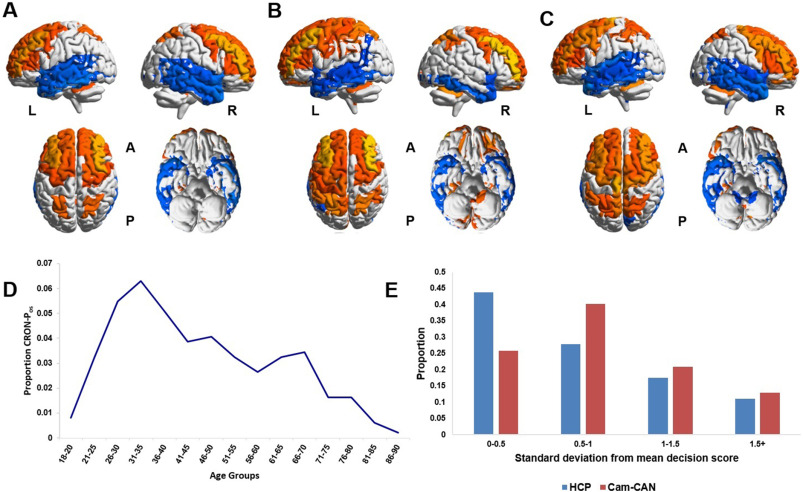 Evidence of discontinuity between psychosis-risk and non-clinical samples in the neuroanatomical correlates of social functionShalaila S Haas, Gaelle E Doucet, Mathilde Antoniades, and 8 more authorsSchizophrenia Research: Cognition, Apr 2022
Evidence of discontinuity between psychosis-risk and non-clinical samples in the neuroanatomical correlates of social functionShalaila S Haas, Gaelle E Doucet, Mathilde Antoniades, and 8 more authorsSchizophrenia Research: Cognition, Apr 2022Objective: Social dysfunction is a major feature of clinical-high-risk states for psychosis (CHR-P). Prior research has identified a neuroanatomical pattern associated with impaired social function outcome in CHR-P. The aim of the current study was to test whether social dysfunction in CHR-P is neurobiologically distinct or in a continuum with the lower end of the normal distribution of individual differences in social functioning. Methods: We used a machine learning classifier to test for the presence of a previously validated brain structural pattern associated with impaired social outcome in CHR-P (CHR-outcome-neurosignature) in the neuroimaging profiles of individuals from two non-clinical samples (total n = 1763) and examined its association with social function, psychopathology and cognition. Results: Although the CHR-outcome-neurosignature could be detected in a subset of the non-clinical samples, it was not associated was adverse social outcomes or higher psychopathology levels. However, participants whose neuroanatomical profiles were highly aligned with the CHR-outcome-neurosignature manifested subtle disadvantage in fluid (PFDR = 0.004) and crystallized intelligence (PFDR = 0.01), cognitive flexibility (PFDR = 0.02), inhibitory control (PFDR = 0.01), working memory (PFDR = 0.0005), and processing speed (PFDR = 0.04). Conclusions: We provide evidence of divergence in brain structural underpinnings of social dysfunction derived from a psychosis-risk enriched population when applied to non-clinical samples. This approach appears promising in identifying brain mechanisms bound to psychosis through comparisons of patient populations to non-clinical samples with the same neuroanatomical profiles.
@article{haas2022evidence, title = {Evidence of discontinuity between psychosis-risk and non-clinical samples in the neuroanatomical correlates of social function}, author = {Haas, Shalaila S and Doucet, Gaelle E and Antoniades, Mathilde and Modabbernia, Amirhossein and Corcoran, Cheryl M and Kahn, Ren{\'e} S and Kambeitz, Joseph and Kambeitz-Ilankovic, Lana and Borgwardt, Stefan and Brambilla, Paolo and others}, journal = {Schizophrenia Research: Cognition}, volume = {29}, pages = {100252}, year = {2022}, month = apr, publisher = {Elsevier}, } -
 A qualitative study on identity in individuals at clinical high risk for psychosis:“… Why does it have to be one thing?”.Cansu Sarac, Joseph S DeLuca, Zarina R Bilgrami, and 8 more authorsPsychiatric Rehabilitation Journal, Mar 2022
A qualitative study on identity in individuals at clinical high risk for psychosis:“… Why does it have to be one thing?”.Cansu Sarac, Joseph S DeLuca, Zarina R Bilgrami, and 8 more authorsPsychiatric Rehabilitation Journal, Mar 2022Objective: Qualitative research can shed light on the subjective experiences of individuals at clinical high risk (CHR) for psychosis, complement quantitative research, broaden our understanding of experiencing CHR, and inform intervention development. The aim of this study was to explore life experiences of individuals at CHR through qualitative research. Method: Participants were 37 individuals at CHR (20 male, 17 female) aged 16–34 (Mage = 23.32 ± 5.26), and 16 healthy controls (HCs; 7 male, 9 female) aged 18–34 (Mage = 25.37 ± 4.05). Qualitative data were obtained through open-ended interviews (30–45 min). No a priori hypotheses were made, and thematic analyses were used to develop themes. Results: Four major themes and one subtheme related to identity were identified through the iterative thematic analysis: defining a self-concept (with a subtheme of creativity), identity development/formation, feeling different from others, and change from a former self. Over 80% of the CHR cohort spontaneously discussed topics related to their identity, compared to 38% of HCs. HCs only reported content within the defining a self-concept theme, while the CHR group reported content within all themes. Conclusions and Implications for Practice: The present study demonstrates that identity formation is a major process for youth in general and that psychosis experiences can make this process more challenging. CHR participants spontaneously brought up multiple themes related to identity in open-ended interviews, suggesting the relevance of this topic in this population. Clinicians should continue to probe identity-related concerns on an individual basis and research should focus on integrating this framework into the conceptualization and treatment of CHR.
@article{sarac2022qualitative, title = {A qualitative study on identity in individuals at clinical high risk for psychosis:“… Why does it have to be one thing?”.}, author = {Sarac, Cansu and DeLuca, Joseph S and Bilgrami, Zarina R and Herrera, Shaynna N and Myers, Jonathan J and Dobbs, Matthew F and Haas, Shalaila S and Todd, Therese L and Srivastava, Agrima and Jespersen, Rachel and others}, journal = {Psychiatric Rehabilitation Journal}, volume = {45}, number = {1}, pages = {44}, year = {2022}, month = mar, publisher = {Educational Publishing Foundation}, } -
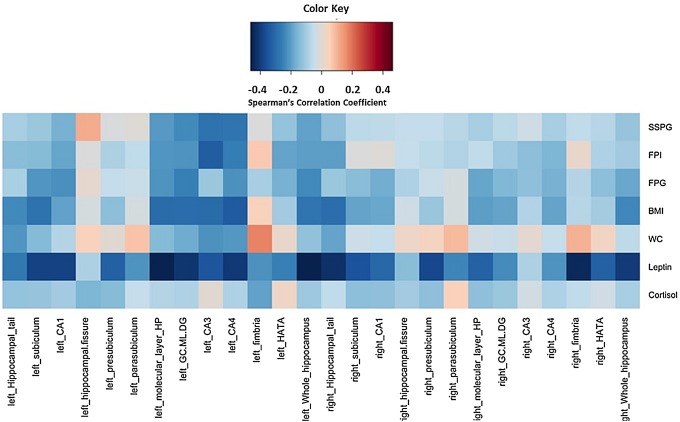 Hippocampal volume reduction is associated with direct measure of insulin resistance in adultsSophia Frangou, Fahim Abbasi, Katie Watson, and 6 more authorsNeuroscience Research, Jan 2022
Hippocampal volume reduction is associated with direct measure of insulin resistance in adultsSophia Frangou, Fahim Abbasi, Katie Watson, and 6 more authorsNeuroscience Research, Jan 2022Hippocampal integrity is highly susceptible to metabolic dysfunction, yet its mechanisms are not well defined. We studied 126 healthy individuals aged 23–61 years. Insulin resistance (IR) was quantified by measuring steady-state plasma glucose (SSPG) concentration during the insulin suppression test. Body mass index (BMI), adiposity, fasting insulin, glucose, leptin as well as structural neuroimaing with automatic hippocampal subfield segmentation were performed. Data analysis using unsupervised machine learning (k-means clustering) identified two subgroups reflecting a pattern of more pronounced hippocampal volume reduction being concurrently associated with greater adiposity and insulin resistance; the hippocampal volume reductions were uniform across subfields. Individuals in the most deviant subgroup were predominantly women (79 versus 42 %) with higher BMI [27.9 (2.5) versus 30.5 (4.6) kg/m^2], IR (SSPG concentration, [156 (61) versus 123 (70) mg/dL] and leptinemia [21.7 (17.0) versus 44.5 (30.4) μg/L]. The use of person-based modeling in healthy individuals suggests that adiposity, insulin resistance and compromised structural hippocampal integrity behave as a composite phenotype; female sex emerged as risk factor for this phenotype.
@article{frangou2022hippocampal, title = {Hippocampal volume reduction is associated with direct measure of insulin resistance in adults}, author = {Frangou, Sophia and Abbasi, Fahim and Watson, Katie and Haas, Shalaila S and Antoniades, Mathilde and Modabbernia, Amirhossein and Myoraku, Alison and Robakis, Thalia and Rasgon, Natalie}, journal = {Neuroscience Research}, volume = {174}, pages = {19--24}, year = {2022}, month = jan, publisher = {Elsevier}, }
2021
-
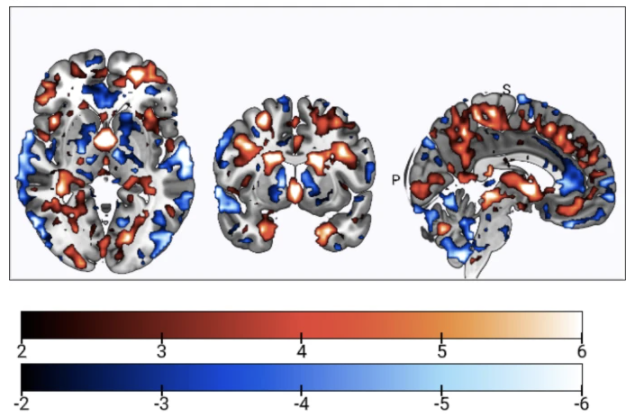 Multivariate pattern analysis of brain structure predicts functional outcome after auditory-based cognitive training interventionsLana Kambeitz-Ilankovic, Sophia Vinogradov, Julian Wenzel, and 7 more authorsnpj Schizophrenia, Aug 2021
Multivariate pattern analysis of brain structure predicts functional outcome after auditory-based cognitive training interventionsLana Kambeitz-Ilankovic, Sophia Vinogradov, Julian Wenzel, and 7 more authorsnpj Schizophrenia, Aug 2021Cognitive gains following cognitive training interventions are associated with improved functioning in people with schizophrenia (SCZ). However, considerable inter-individual variability is observed. Here, we evaluate the sensitivity of brain structural features to predict functional response to auditory-based cognitive training (ABCT) at a single-subject level. We employed whole-brain multivariate pattern analysis with support vector machine (SVM) modeling to identify gray matter (GM) patterns that predicted higher vs. lower functioning after 40 h of ABCT at the single-subject level in SCZ patients. The generalization capacity of the SVM model was evaluated by applying the original model through an out-of-sample cross-validation analysis to unseen SCZ patients from an independent validation sample who underwent 50 h of ABCT. The whole-brain GM volume-based pattern classification predicted higher vs. lower functioning at follow-up with a balanced accuracy (BAC) of 69.4% (sensitivity 72.2%, specificity 66.7%) as determined by nested cross-validation. The neuroanatomical model was generalizable to an independent cohort with a BAC of 62.1% (sensitivity 90.9%, specificity 33.3%). In particular, greater baseline GM volumes in regions within superior temporal gyrus, thalamus, anterior cingulate, and cerebellum predicted improved functioning at the single-subject level following ABCT in SCZ participants. The present findings provide a structural MRI fingerprint associated with preserved GM volumes at a single baseline timepoint, which predicted improved functioning following an ABCT intervention, and serve as a model for how to facilitate precision clinical therapies for SCZ based on imaging data, operating at the single-subject level.
@article{kambeitz2021multivariate, title = {Multivariate pattern analysis of brain structure predicts functional outcome after auditory-based cognitive training interventions}, author = {Kambeitz-Ilankovic, Lana and Vinogradov, Sophia and Wenzel, Julian and Fisher, Melissa and Haas, Shalaila S and Betz, Linda and Penzel, Nora and Nagarajan, Srikantan and Koutsouleris, Nikolaos and Subramaniam, Karuna}, journal = {npj Schizophrenia}, volume = {7}, number = {1}, pages = {1--8}, year = {2021}, month = aug, publisher = {Nature Publishing Group}, } -
 Personalized estimates of brain structural variability in individuals with early psychosisMathilde Antoniades, Shalaila S Haas, Amirhossein Modabbernia, and 4 more authorsSchizophrenia bulletin, Jul 2021
Personalized estimates of brain structural variability in individuals with early psychosisMathilde Antoniades, Shalaila S Haas, Amirhossein Modabbernia, and 4 more authorsSchizophrenia bulletin, Jul 2021Background: Early psychosis in first-episode psychosis (FEP) and clinical high-risk (CHR) individuals has been associated with alterations in mean regional measures of brain morphology. Examination of variability in brain morphology could assist in quantifying the degree of brain structural heterogeneity in clinical relative to healthy control (HC) samples. Methods: Structural magnetic resonance imaging data were obtained from CHR (n = 71), FEP (n = 72), and HC individuals (n = 55). Regional brain variability in cortical thickness (CT), surface area (SA), and subcortical volume (SV) was assessed with the coefficient of variation (CV). Furthermore, the person-based similarity index (PBSI) was employed to quantify the similarity of CT, SA, and SV profile of each individual to others within the same diagnostic group. Normative modeling of the PBSI-CT, PBSI-SA, and PBSI-SV was used to identify CHR and FEP individuals whose scores deviated markedly from those of the healthy individuals. Results: There was no effect of diagnosis on the CV for any regional measure (P > .38). CHR and FEP individuals differed significantly from the HC group in terms of PBSI-CT (P < .0001), PBSI-SA (P < .0001), and PBSI-SV (P = .01). In the clinical groups, normative modeling identified 32 (22%) individuals with deviant PBSI-CT, 12 (8.4%) with deviant PBSI-SA, and 21 (15%) with deviant PBSI-SV; differences of small effect size indicated that individuals with deviant PBSI scores had lower IQ and higher psychopathology. Conclusions: Examination of brain structural variability in early psychosis indicated heterogeneity at the level of individual profiles and encourages further large-scale examination to identify individuals that deviate markedly from normative reference data.
@article{antoniades2021personalized, title = {Personalized estimates of brain structural variability in individuals with early psychosis}, author = {Antoniades, Mathilde and Haas, Shalaila S and Modabbernia, Amirhossein and Bykowsky, Oleg and Frangou, Sophia and Borgwardt, Stefan and Schmidt, Andr{\'e}}, journal = {Schizophrenia bulletin}, volume = {47}, number = {4}, pages = {1029--1038}, year = {2021}, month = jul, publisher = {Oxford University Press US}, } -
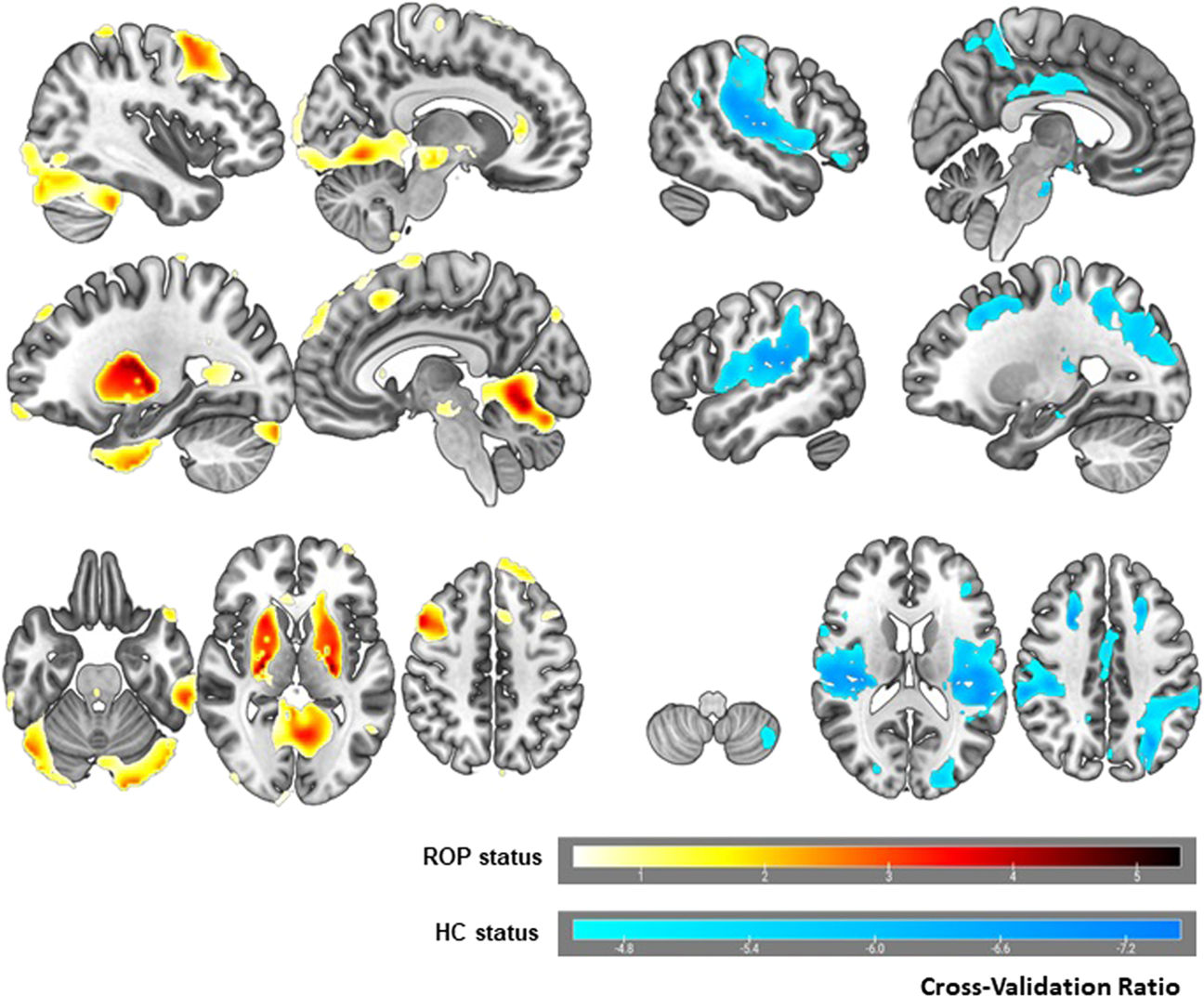 Cognitive subtypes in recent onset psychosis: distinct neurobiological fingerprints?Julian Wenzel, Shalaila S Haas, Dominic B Dwyer, and 8 more authorsNeuropsychopharmacology, Jul 2021
Cognitive subtypes in recent onset psychosis: distinct neurobiological fingerprints?Julian Wenzel, Shalaila S Haas, Dominic B Dwyer, and 8 more authorsNeuropsychopharmacology, Jul 2021In schizophrenia, neurocognitive subtypes can be distinguished based on cognitive performance and they are associated with neuroanatomical alterations. We investigated the existence of cognitive subtypes in shortly medicated recent onset psychosis patients, their underlying gray matter volume patterns and clinical characteristics. We used a K-means algorithm to cluster 108 psychosis patients from the multi-site EU PRONIA (Prognostic tools for early psychosis management) study based on cognitive performance and validated the solution independently (N = 53). Cognitive subgroups and healthy controls (HC; n = 195) were classified based on gray matter volume (GMV) using Support Vector Machine classification. A cognitively spared (N = 67) and impaired (N = 41) subgroup were revealed and partially independently validated (N-spared = 40, N-impaired = 13). Impaired patients showed significantly increased negative symptomatology (pfdr = 0.003), reduced cognitive performance (pfdr < 0.001) and general functioning (pfdr < 0.035) in comparison to spared patients. Neurocognitive deficits of the impaired subgroup persist in both discovery and validation sample across several domains, including verbal memory and processing speed. A GMV pattern (balanced accuracy = 60.1%, p = 0.01) separating impaired patients from HC revealed increases and decreases across several fronto-temporal-parietal brain areas, including basal ganglia and cerebellum. Cognitive and functional disturbances alongside brain morphological changes in the impaired subgroup are consistent with a neurodevelopmental origin of psychosis. Our findings emphasize the relevance of tailored intervention early in the course of psychosis for patients suffering from the likely stronger neurodevelopmental character of the disease.
@article{wenzel2021cognitive, title = {Cognitive subtypes in recent onset psychosis: distinct neurobiological fingerprints?}, author = {Wenzel, Julian and Haas, Shalaila S and Dwyer, Dominic B and Ruef, Anne and Oeztuerk, Oemer Faruk and Antonucci, Linda A and von Saldern, Sebastian and Bonivento, Carolina and Garzitto, Marco and Ferro, Adele and others}, journal = {Neuropsychopharmacology}, volume = {46}, number = {8}, pages = {1475--1483}, year = {2021}, month = jul, publisher = {Nature Publishing Group}, } -
 Association of structural magnetic resonance imaging measures with psychosis onset in individuals at clinical high risk for developing psychosis: an ENIGMA working group mega-analysisMaria Jalbrzikowski, Rebecca A Hayes, Stephen J Wood, and 8 more authorsJAMA psychiatry, Jul 2021
Association of structural magnetic resonance imaging measures with psychosis onset in individuals at clinical high risk for developing psychosis: an ENIGMA working group mega-analysisMaria Jalbrzikowski, Rebecca A Hayes, Stephen J Wood, and 8 more authorsJAMA psychiatry, Jul 2021Importance: The ENIGMA clinical high risk (CHR) for psychosis initiative, the largest pooled neuroimaging sample of individuals at CHR to date, aims to discover robust neurobiological markers of psychosis risk. Objective: To investigate baseline structural neuroimaging differences between individuals at CHR and healthy controls as well as between participants at CHR who later developed a psychotic disorder (CHR-PS+) and those who did not (CHR-PS−). Design, Setting, and Participants: In this case-control study, baseline T1-weighted magnetic resonance imaging (MRI) data were pooled from 31 international sites participating in the ENIGMA Clinical High Risk for Psychosis Working Group. CHR status was assessed using the Comprehensive Assessment of At-Risk Mental States or Structured Interview for Prodromal Syndromes. MRI scans were processed using harmonized protocols and analyzed within a mega-analysis and meta-analysis framework from January to October 2020. Main Outcomes and Measures: Measures of regional cortical thickness (CT), surface area, and subcortical volumes were extracted from T1-weighted MRI scans. Independent variables were group (CHR group vs control group) and conversion status (CHR-PS+ group vs CHR-PS− group vs control group). Results: Of the 3169 included participants, 1428 (45.1%) were female, and the mean (SD; range) age was 21.1 (4.9; 9.5-39.9) years. This study included 1792 individuals at CHR and 1377 healthy controls. Using longitudinal clinical information, 253 in the CHR-PS+ group, 1234 in the CHR-PS− group, and 305 at CHR without follow-up data were identified. Compared with healthy controls, individuals at CHR exhibited widespread lower CT measures (mean [range] Cohen d = −0.13 [−0.17 to −0.09]), but not surface area or subcortical volume. Lower CT measures in the fusiform, superior temporal, and paracentral regions were associated with psychosis conversion (mean Cohen d = −0.22; 95% CI, −0.35 to 0.10). Among healthy controls, compared with those in the CHR-PS+ group, age showed a stronger negative association with left fusiform CT measures (F = 9.8; P < .001; q < .001) and left paracentral CT measures (F = 5.9; P = .005; q = .02). Effect sizes representing lower CT associated with psychosis conversion resembled patterns of CT differences observed in ENIGMA studies of schizophrenia (ρ = 0.35; 95% CI, 0.12 to 0.55; P = .004) and individuals with 22q11.2 microdeletion syndrome and a psychotic disorder diagnosis (ρ = 0.43; 95% CI, 0.20 to 0.61; P = .001). Conclusions and Relevance: This study provides evidence for widespread subtle, lower CT measures in individuals at CHR. The pattern of CT measure differences in those in the CHR-PS+ group was similar to those reported in other large-scale investigations of psychosis. Additionally, a subset of these regions displayed abnormal age associations. Widespread disruptions in CT coupled with abnormal age associations in those at CHR may point to disruptions in postnatal brain developmental processes.
@article{jalbrzikowski2021association, title = {Association of structural magnetic resonance imaging measures with psychosis onset in individuals at clinical high risk for developing psychosis: an ENIGMA working group mega-analysis}, author = {Jalbrzikowski, Maria and Hayes, Rebecca A and Wood, Stephen J and Nordholm, Dorte and Zhou, Juan H and Fusar-Poli, Paolo and Uhlhaas, Peter J and Takahashi, Tsutomu and Sugranyes, Gisela and Kwak, Yoo Bin and others}, journal = {JAMA psychiatry}, volume = {78}, number = {7}, pages = {753--766}, year = {2021}, month = jul, publisher = {American Medical Association}, } -
 Multimodal prognosis of negative symptom severity in individuals at increased risk of developing psychosisDaniel J Hauke, André Schmidt, Erich Studerus, and 8 more authorsTranslational psychiatry, May 2021
Multimodal prognosis of negative symptom severity in individuals at increased risk of developing psychosisDaniel J Hauke, André Schmidt, Erich Studerus, and 8 more authorsTranslational psychiatry, May 2021Negative symptoms occur frequently in individuals at clinical high risk (CHR) for psychosis and contribute to functional impairments. The aim of this study was to predict negative symptom severity in CHR after 9 months. Predictive models either included baseline negative symptoms measured with the Structured Interview for Psychosis-Risk Syndromes (SIPS-N), whole-brain gyrification, or both to forecast negative symptoms of at least moderate severity in 94 CHR. We also conducted sequential risk stratification to stratify CHR into different risk groups based on the SIPS-N and gyrification model. Additionally, we assessed the models’ ability to predict functional outcomes in CHR and their transdiagnostic generalizability to predict negative symptoms in 96 patients with recent-onset psychosis (ROP) and 97 patients with recent-onset depression (ROD). Baseline SIPS-N and gyrification predicted moderate/severe negative symptoms with significant balanced accuracies of 68 and 62%, while the combined model achieved 73% accuracy. Sequential risk stratification stratified CHR into a high (83%), medium (40–64%), and low (19%) risk group regarding their risk of having moderate/severe negative symptoms at 9 months follow-up. The baseline SIPS-N model was also able to predict social (61%), but not role functioning (59%) at above-chance accuracies, whereas the gyrification model achieved significant accuracies in predicting both social (76%) and role (74%) functioning in CHR. Finally, only the baseline SIPS-N model showed transdiagnostic generalization to ROP (63%). This study delivers a multimodal prognostic model to identify those CHR with a clinically relevant negative symptom severity and functional impairments, potentially requiring further therapeutic consideration.
@article{hauke2021multimodal, title = {Multimodal prognosis of negative symptom severity in individuals at increased risk of developing psychosis}, author = {Hauke, Daniel J and Schmidt, Andr{\'e} and Studerus, Erich and Andreou, Christina and Riecher-R{\"o}ssler, Anita and Radua, Joaquim and Kambeitz, Joseph and Ruef, Anne and Dwyer, Dominic B and Kambeitz-Ilankovic, Lana and others}, journal = {Translational psychiatry}, volume = {11}, number = {1}, pages = {1--11}, year = {2021}, month = may, publisher = {Nature Publishing Group}, } -
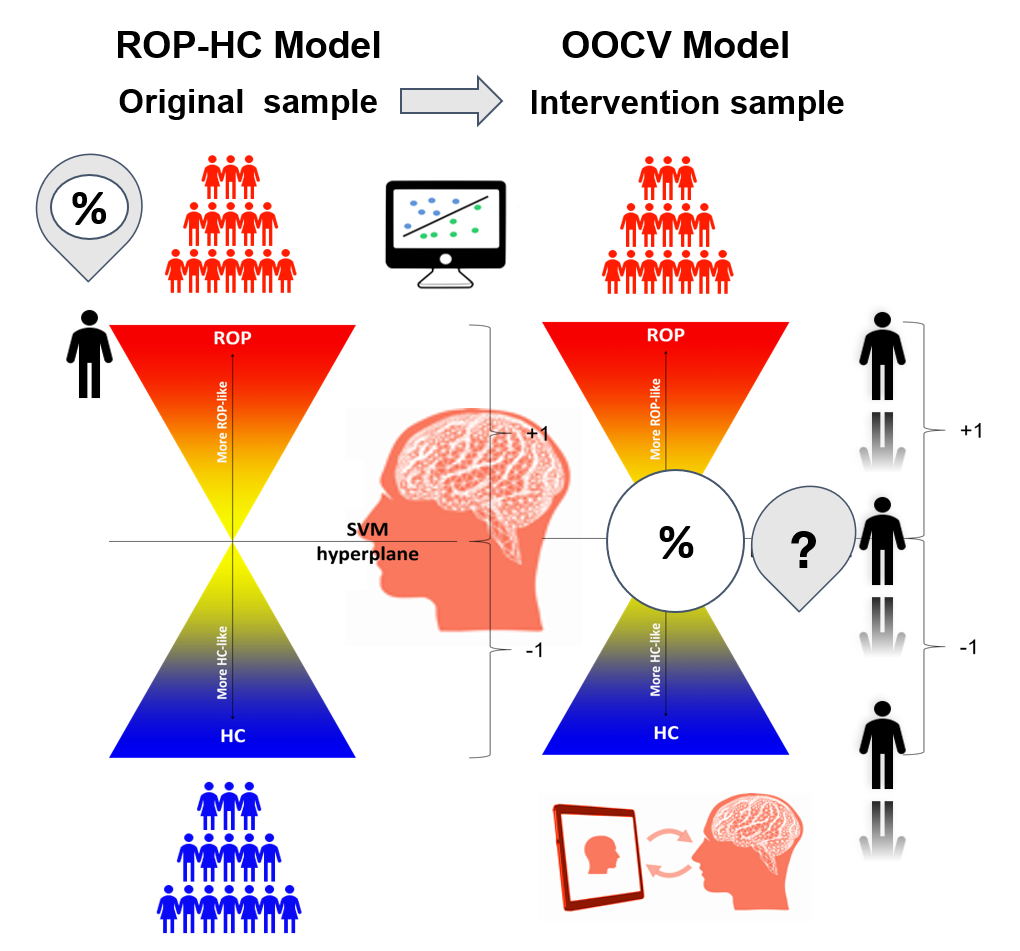 A multivariate neuromonitoring approach to neuroplasticity-based computerized cognitive training in recent onset psychosisShalaila S Haas, Linda A Antonucci, Julian Wenzel, and 8 more authorsNeuropsychopharmacology, Mar 2021
A multivariate neuromonitoring approach to neuroplasticity-based computerized cognitive training in recent onset psychosisShalaila S Haas, Linda A Antonucci, Julian Wenzel, and 8 more authorsNeuropsychopharmacology, Mar 2021Two decades of studies suggest that computerized cognitive training (CCT) has an effect on cognitive improvement and the restoration of brain activity. Nevertheless, individual response to CCT remains heterogenous, and the predictive potential of neuroimaging in gauging response to CCT remains unknown. We employed multivariate pattern analysis (MVPA) on whole-brain resting-state functional connectivity (rsFC) to (neuro)monitor clinical outcome defined as psychosis-likeness change after 10-hours of CCT in recent onset psychosis (ROP) patients. Additionally, we investigated if sensory processing (SP) change during CCT is associated with individual psychosis-likeness change and cognitive gains after CCT. 26 ROP patients were divided into maintainers and improvers based on their SP change during CCT. A support vector machine (SVM) classifier separating 56 healthy controls (HC) from 35 ROP patients using rsFC (balanced accuracy of 65.5%, P < 0.01) was built in an independent sample to create a naturalistic model representing the HC-ROP hyperplane. This model was out-of-sample cross-validated in the ROP patients from the CCT trial to assess associations between rsFC pattern change, cognitive gains and SP during CCT. Patients with intact SP threshold at baseline showed improved attention despite psychosis status on the SVM hyperplane at follow-up (p < 0.05). Contrarily, the attentional gains occurred in the ROP patients who showed impaired SP at baseline only if rsfMRI diagnosis status shifted to the healthy-like side of the SVM continuum. Our results reveal the utility of MVPA for elucidating treatment response neuromarkers based on rsFC-SP change and pave the road to more personalized interventions.
@article{haas2021multivariate, title = {A multivariate neuromonitoring approach to neuroplasticity-based computerized cognitive training in recent onset psychosis}, author = {Haas, Shalaila S and Antonucci, Linda A and Wenzel, Julian and Ruef, Anne and Biagianti, Bruno and Paolini, Marco and Rauchmann, Boris-Stephan and Weiske, Johanna and Kambeitz, Joseph and Borgwardt, Stefan and others}, journal = {Neuropsychopharmacology}, volume = {46}, number = {4}, pages = {828--835}, year = {2021}, month = mar, publisher = {Nature Publishing Group}, } -
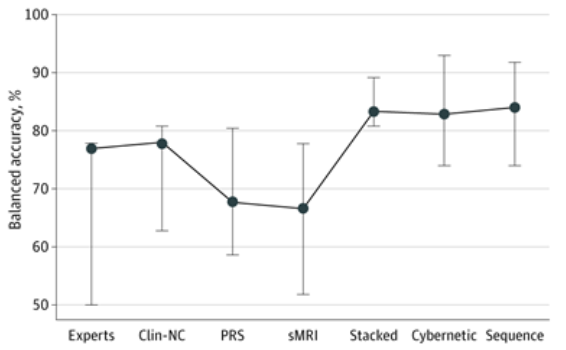 Multimodal machine learning workflows for prediction of psychosis in patients with clinical high-risk syndromes and recent-onset depressionNikolaos Koutsouleris, Dominic B Dwyer, Franziska Degenhardt, and 8 more authorsJAMA psychiatry, Feb 2021
Multimodal machine learning workflows for prediction of psychosis in patients with clinical high-risk syndromes and recent-onset depressionNikolaos Koutsouleris, Dominic B Dwyer, Franziska Degenhardt, and 8 more authorsJAMA psychiatry, Feb 2021Importance: Diverse models have been developed to predict psychosis in patients with clinical high-risk (CHR) states. Whether prediction can be improved by efficiently combining clinical and biological models and by broadening the risk spectrum to young patients with depressive syndromes remains unclear. Objectives: To evaluate whether psychosis transition can be predicted in patients with CHR or recent-onset depression (ROD) using multimodal machine learning that optimally integrates clinical and neurocognitive data, structural magnetic resonance imaging (sMRI), and polygenic risk scores (PRS) for schizophrenia; to assess models’ geographic generalizability; to test and integrate clinicians’ predictions; and to maximize clinical utility by building a sequential prognostic system. Design, Setting, and Participants: This multisite, longitudinal prognostic study performed in 7 academic early recognition services in 5 European countries followed up patients with CHR syndromes or ROD and healthy volunteers. The referred sample of 167 patients with CHR syndromes and 167 with ROD was recruited from February 1, 2014, to May 31, 2017, of whom 26 (23 with CHR syndromes and 3 with ROD) developed psychosis. Patients with 18-month follow-up (n = 246) were used for model training and leave-one-site-out cross-validation. The remaining 88 patients with nontransition served as the validation of model specificity. Three hundred thirty-four healthy volunteers provided a normative sample for prognostic signature evaluation. Three independent Swiss projects contributed a further 45 cases with psychosis transition and 600 with nontransition for the external validation of clinical-neurocognitive, sMRI-based, and combined models. Data were analyzed from January 1, 2019, to March 31, 2020. Main Outcomes and Measures: Accuracy and generalizability of prognostic systems. Results: A total of 668 individuals (334 patients and 334 controls) were included in the analysis (mean [SD] age, 25.1 [5.8] years; 354 [53.0%] female and 314 [47.0%] male). Clinicians attained a balanced accuracy of 73.2% by effectively ruling out (specificity, 84.9%) but ineffectively ruling in (sensitivity, 61.5%) psychosis transition. In contrast, algorithms showed high sensitivity (76.0%-88.0%) but low specificity (53.5%-66.8%). A cybernetic risk calculator combining all algorithmic and human components predicted psychosis with a balanced accuracy of 85.5% (sensitivity, 84.6%; specificity, 86.4%). In comparison, an optimal prognostic workflow produced a balanced accuracy of 85.9% (sensitivity, 84.6%; specificity, 87.3%) at a much lower diagnostic burden by sequentially integrating clinical-neurocognitive, expert-based, PRS-based, and sMRI-based risk estimates as needed for the given patient. Findings were supported by good external validation results. Conclusions and Relevance: These findings suggest that psychosis transition can be predicted in a broader risk spectrum by sequentially integrating algorithms’ and clinicians’ risk estimates. For clinical translation, the proposed workflow should undergo large-scale international validation.
@article{koutsouleris2021multimodal, title = {Multimodal machine learning workflows for prediction of psychosis in patients with clinical high-risk syndromes and recent-onset depression}, author = {Koutsouleris, Nikolaos and Dwyer, Dominic B and Degenhardt, Franziska and Maj, Carlo and Urquijo-Castro, Maria Fernanda and Sanfelici, Rachele and Popovic, David and Oeztuerk, Oemer and Haas, Shalaila S and Weiske, Johanna and others}, journal = {JAMA psychiatry}, volume = {78}, number = {2}, pages = {195--209}, year = {2021}, month = feb, publisher = {American Medical Association}, } -
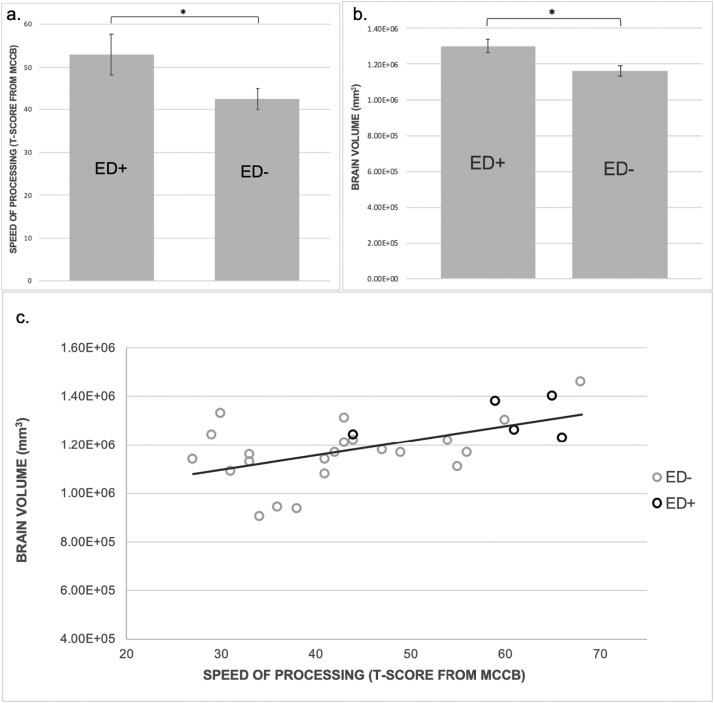 Processing speed and brain volume in individuals at clinical high-risk for psychosis with comorbid eating disorders: A brief reportCansu Sarac, Zarina R Bilgrami, Shalaila S Haas, and 5 more authorsSchizophrenia research, Jan 2021
Processing speed and brain volume in individuals at clinical high-risk for psychosis with comorbid eating disorders: A brief reportCansu Sarac, Zarina R Bilgrami, Shalaila S Haas, and 5 more authorsSchizophrenia research, Jan 2021@article{sarac2021processing, title = {Processing speed and brain volume in individuals at clinical high-risk for psychosis with comorbid eating disorders: A brief report}, author = {Sarac, Cansu and Bilgrami, Zarina R and Haas, Shalaila S and Herrera, Shaynna N and Myers, Jonathan J and Nelson, Barnaby and Malaspina, Dolores and Corcoran, Cheryl M}, journal = {Schizophrenia research}, volume = {227}, pages = {92--94}, year = {2021}, month = jan, } -
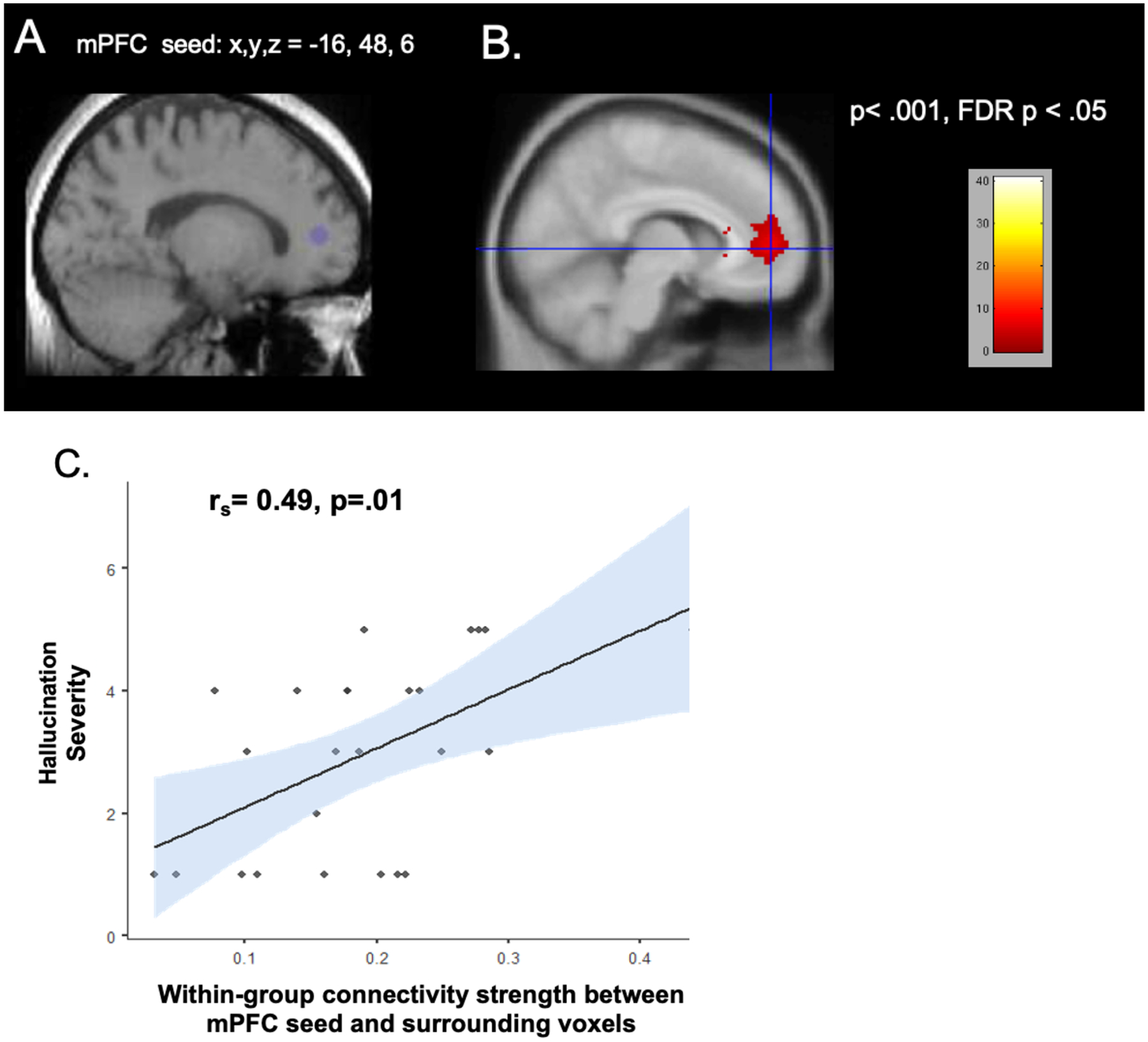 A neural biomarker for hallucinations: medial prefrontal aberrations in neural connectivity predict self-agency deficits and hallucination severity in schizophreniaShalaila S Haas, Leighton BN Hinkley, Melissa Fisher, and 3 more authorsJournal of brain research, May 2021
A neural biomarker for hallucinations: medial prefrontal aberrations in neural connectivity predict self-agency deficits and hallucination severity in schizophreniaShalaila S Haas, Leighton BN Hinkley, Melissa Fisher, and 3 more authorsJournal of brain research, May 2021Prior studies have shown that the medial prefrontal cortex (mPFC) represents one neural substrate that mediates judgments of self-agency (i.e., the awareness that ‘I am the originator of my actions’). Patients with schizophrenia (SZ) manifest cardinal self-agency deficits that contribute to debilitating psychotic symptoms (e.g. hallucinations) and distort reality monitoring. This is the first study in which we examine across 2 SZ samples, the mPFC site that underlies self-agency deficits during an explicit reality-monitoring task (i.e., while subjects distinguish self-generated information from externally-derived information) in one SZ sample, and link intrinsic functional connectivity (iFC) during rest within this a priori task-evoked self-agency seed with hallucination symptoms in a different SZ sample. In particular, we examined the iFC between the mPFC site that underlies self-agency deficits with all other brain regions in SZ using resting-state functional magnetic resonance imaging (fMRI). Resting-state fMRI data were collected from 32 SZ and 28 age, gender, and education-matched healthy control (HC) subjects. Functional connectivity maps were computed for each subject and compared between the HC and SZ groups. Within-group and between-group analyses revealed that aberrant iFC in this a priori-defined mPFC ‘self-agency seed’ predicted hallucination severity. The present findings reveal that the neural aberrations in this mPFC site represents one cardinal biomarker that underlies explicit self-agency deficits during a reality-monitoring task in one SZ sample that generalized to aberrant iFC differences in a different SZ sample and predicted worsening psychotic hallucinatory experiences. This region may represent a key neurobiological target for treatment avenues to improve hallucinatory symptoms.
@article{haas2021neural, title = {A neural biomarker for hallucinations: medial prefrontal aberrations in neural connectivity predict self-agency deficits and hallucination severity in schizophrenia}, author = {Haas, Shalaila S and Hinkley, Leighton BN and Fisher, Melissa and Vinogradov, Sophia and Nagarajan, Srikantan and Subramaniam, Karuna}, journal = {Journal of brain research}, volume = {4}, number = {3}, month = may, year = {2021}, publisher = {NIH Public Access}, }
2020
-
 Modeling social sensory processing during social computerized cognitive training for psychosis spectrum: the resting-state approachLana Kambeitz-Ilankovic, Julian Wenzel, Shalaila S Haas, and 6 more authorsFrontiers in Psychiatry, Nov 2020
Modeling social sensory processing during social computerized cognitive training for psychosis spectrum: the resting-state approachLana Kambeitz-Ilankovic, Julian Wenzel, Shalaila S Haas, and 6 more authorsFrontiers in Psychiatry, Nov 2020Background: Greater impairments in early sensory processing predict response to auditory computerized cognitive training (CCT) in patients with recent-onset psychosis (ROP). Little is known about neuroimaging predictors of response to social CCT, an experimental treatment that was recently shown to induce cognitive improvements in patients with psychosis. Here, we investigated whether ROP patients show interindividual differences in sensory processing change and whether different patterns of SPC are (1) related to the differential response to treatment, as indexed by gains in social cognitive neuropsychological tests and (2) associated with unique resting-state functional connectivity (rsFC). Methods: Twenty-six ROP patients completed 10 h of CCT over the period of 4–6 weeks. Subject-specific improvement in one CCT exercise targeting early sensory processing—a speeded facial Emotion Matching Task (EMT)—was studied as potential proxy for target engagement. Based on the median split of SPC from the EMT, two patient groups were created. Resting-state activity was collected at baseline, and bold time series were extracted from two major default mode network (DMN) hubs: left medial prefrontal cortex (mPFC) and left posterior cingulate cortex (PCC). Seed rsFC analysis was performed using standardized Pearson correlation matrices, generated between the average time course for each seed and each voxel in the brain. Results: Based on SPC, we distinguished improvers—i.e., participants who showed impaired performance at baseline and reached the EMT psychophysical threshold during CCT—from maintainers—i.e., those who showed intact EMT performance at baseline and sustained the EMT psychophysical threshold throughout CCT. Compared to maintainers, improvers showed an increase of rsFC at rest between PCC and left superior and medial frontal regions and the cerebellum. Compared to improvers, maintainers showed increased rsFC at baseline between PCC and superior temporal and insular regions bilaterally. Conclusions: In ROP patients with an increase of connectivity at rest in the default mode network, social CCT is still able to induce sensory processing changes that however do not translate into social cognitive gains. Future studies should investigate if impairments in short-term synaptic plasticity are responsible for this lack of response and can be remediated by pharmacological augmentation during CCT.
@article{kambeitz2020modeling, title = {Modeling social sensory processing during social computerized cognitive training for psychosis spectrum: the resting-state approach}, author = {Kambeitz-Ilankovic, Lana and Wenzel, Julian and Haas, Shalaila S and Ruef, Anne and Antonucci, Linda A and Sanfelici, Rachele and Paolini, Marco and Koutsouleris, Nikolaos and Biagianti, Bruno}, journal = {Frontiers in Psychiatry}, volume = {11}, pages = {554475}, year = {2020}, month = nov, publisher = {Frontiers Media SA}, } -
 Linking language features to clinical symptoms and multimodal imaging in individuals at clinical high risk for psychosisShalaila S Haas, Gaelle E Doucet, Sahil Garg, and 5 more authorsEuropean Psychiatry, Aug 2020
Linking language features to clinical symptoms and multimodal imaging in individuals at clinical high risk for psychosisShalaila S Haas, Gaelle E Doucet, Sahil Garg, and 5 more authorsEuropean Psychiatry, Aug 2020Background: Abnormalities in the semantic and syntactic organization of speech have been reported in individuals at clinical high-risk (CHR) for psychosis. The current study seeks to examine whether such abnormalities are associated with changes in brain structure and functional connectivity in CHR individuals. Methods: Automated natural language processing analysis was applied to speech samples obtained from 46 CHR and 22 healthy individuals. Brain structural and resting-state functional imaging data were also acquired from all participants. Sparse canonical correlation analysis (sCCA) was used to ascertain patterns of covariation between linguistic features, clinical symptoms, and measures of brain morphometry and functional connectivity related to the language network. Results: In CHR individuals, we found a significant mode of covariation between linguistic and clinical features (r = 0.73; p = 0.003), with negative symptoms and bizarre thinking covarying mostly with measures of syntactic complexity. In the entire sample, separate sCCAs identified a single mode of covariation linking linguistic features with brain morphometry (r = 0.65; p = 0.05) and resting-state network connectivity (r = 0.63; p = 0.01). In both models, semantic and syntactic features covaried with brain structural and functional connectivity measures of the language network. However, the contribution of diagnosis to both models was negligible. Conclusions: Syntactic complexity appeared sensitive to prodromal symptoms in CHR individuals while the patterns of brain-language covariation seemed preserved. Further studies in larger samples are required to establish the reproducibility of these findings.
@article{haas2020linking, title = {Linking language features to clinical symptoms and multimodal imaging in individuals at clinical high risk for psychosis}, author = {Haas, Shalaila S and Doucet, Gaelle E and Garg, Sahil and Herrera, Shaynna N and Sarac, Cansu and Bilgrami, Zarina R and Shaik, Riaz B and Corcoran, Cheryl M}, journal = {European Psychiatry}, volume = {63}, number = {1}, year = {2020}, month = aug, publisher = {Cambridge University Press}, } -
 Be Careful What You Feed Your Brain: Cannabis and Mental HealthSrivaishnavi Loganathan, Dorothee Pöhlchen, Elena Brivio, and 7 more authorsFrontiers for Young Minds, May 2020
Be Careful What You Feed Your Brain: Cannabis and Mental HealthSrivaishnavi Loganathan, Dorothee Pöhlchen, Elena Brivio, and 7 more authorsFrontiers for Young Minds, May 2020Adolescence is an important period when the brain undergoes many changes. Because the brain is changing so much at this time, our experiences can have a huge impact on the brain’s health. Positive experiences keep the mind healthy, whereas negative experiences can lead to mental disorders. To process all the information that comes into the brain, the brain cells must talk with each other. They communicate via messenger systems. One of these systems is called the endocannabinoid (eCB) system. The eCB system plays an important role in the changes that happen in the adolescent brain. In this article, we see how the eCB system is affected by cannabis and how this may lead to a mental disorder.
@article{loganathancareful, title = {Be Careful What You Feed Your Brain: Cannabis and Mental Health}, author = {Loganathan, Srivaishnavi and P{\"o}hlchen, Dorothee and Brivio, Elena and Comes, Ashley L and Haas, Shalaila S and Kalman, Janos L and Krontira, Anthi C and Stamp, Fabian and Hoch, Eva and Wotjak, Carsten T}, journal = {Frontiers for Young Minds}, volume = {8}, pages = {41}, year = {2020}, month = may, publisher = {Frontiers}, } -
 Multivariate classification of schizophrenia and its familial risk based on load-dependent attentional control brain functional connectivityLinda A Antonucci, Nora Penzel, Giulio Pergola, and 8 more authorsNeuropsychopharmacology, Mar 2020
Multivariate classification of schizophrenia and its familial risk based on load-dependent attentional control brain functional connectivityLinda A Antonucci, Nora Penzel, Giulio Pergola, and 8 more authorsNeuropsychopharmacology, Mar 2020Patients with schizophrenia (SCZ), as well as their unaffected siblings (SIB), show functional connectivity (FC) alterations during performance of tasks involving attention. As compared with SCZ, these alterations are present in SIB to a lesser extent and are more pronounced during high cognitive demand, thus possibly representing one of the pathways in which familial risk is translated into the SCZ phenotype. Our aim is to measure the separability of SCZ and SIB from healthy controls (HC) using attentional control-dependent FC patterns, and to test to which extent these patterns span a continuum of neurofunctional alterations between HC and SCZ. 65 SCZ with 65 age and gender-matched HC and 39 SIB with 39 matched HC underwent the Variable Attentional Control (VAC) task. Load-dependent connectivity matrices were generated according to correct responses in each VAC load. Classification performances of high, intermediate and low VAC load FC on HC-SCZ and HC-SIB cohorts were tested through machine learning techniques within a repeated nested cross-validation framework. HC-SCZ classification models were applied to the HC-SIB cohort, and vice-versa. A high load-related decreased FC pattern discriminated between HC and SCZ with 66.9% accuracy and with 57.7% accuracy between HC and SIB. A high load-related increased FC network separated SIB from HC (69.6% accuracy), but not SCZ from HC (48.5% accuracy). Our findings revealed signatures of attentional FC abnormalities shared by SCZ and SIB individuals. We also found evidence for potential, SIB-specific FC signature, which may point to compensatory neurofunctional mechanisms in persons at familial risk for schizophrenia.
@article{antonucci2020multivariate, title = {Multivariate classification of schizophrenia and its familial risk based on load-dependent attentional control brain functional connectivity}, author = {Antonucci, Linda A and Penzel, Nora and Pergola, Giulio and Kambeitz-Ilankovic, Lana and Dwyer, Dominic and Kambeitz, Joseph and Haas, Shalaila S and Passiatore, Roberta and Fazio, Leonardo and Caforio, Grazia and others}, journal = {Neuropsychopharmacology}, volume = {45}, number = {4}, pages = {613--621}, year = {2020}, month = mar, publisher = {Nature Publishing Group}, }
2019
-
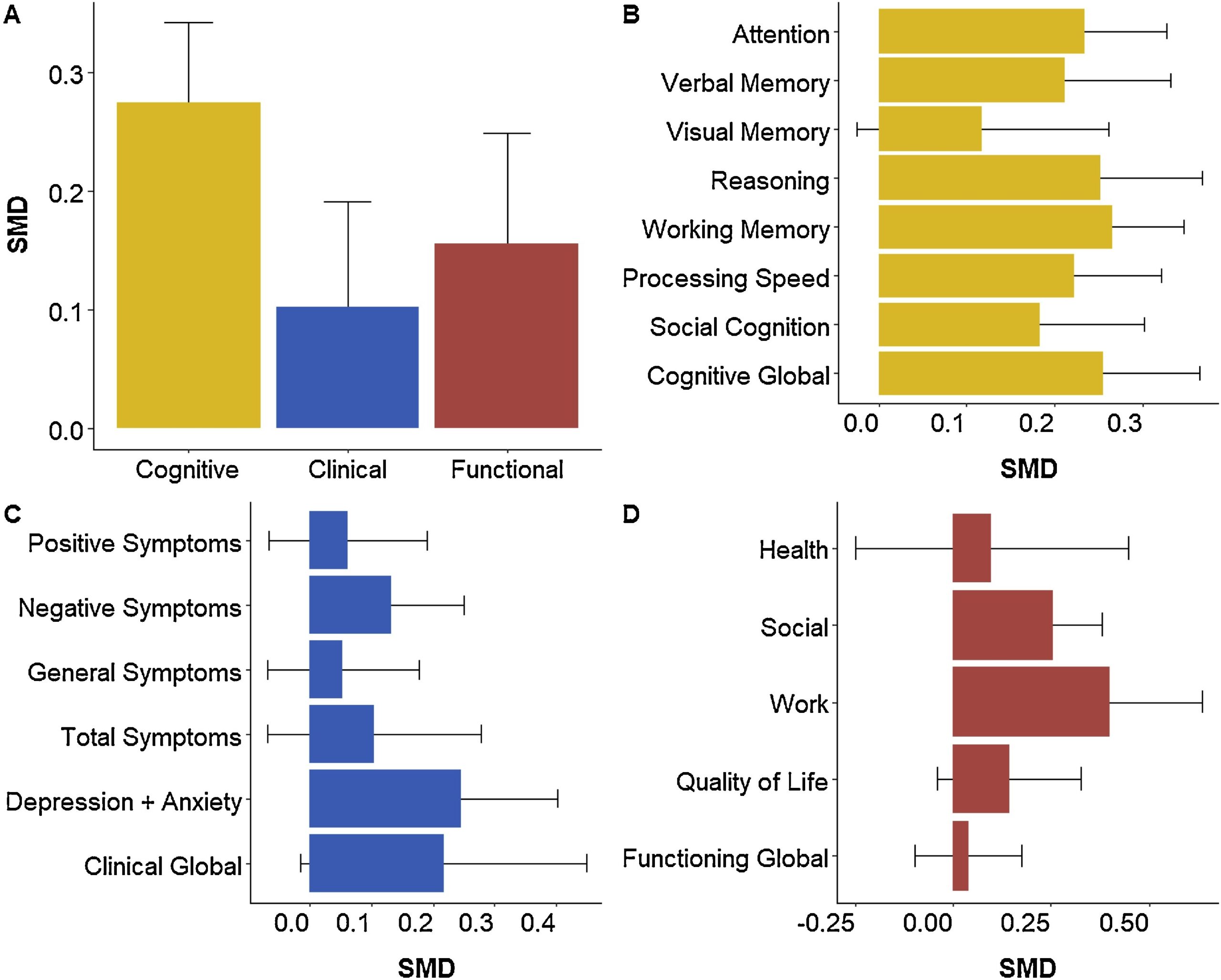 Multi-outcome meta-analysis (MOMA) of cognitive remediation in schizophrenia: revisiting the relevance of human coaching and elucidating interplay between multiple outcomesLana Kambeitz-Ilankovic, Linda T Betz, Clara Dominke, and 6 more authorsNeuroscience & Biobehavioral Reviews, Dec 2019
Multi-outcome meta-analysis (MOMA) of cognitive remediation in schizophrenia: revisiting the relevance of human coaching and elucidating interplay between multiple outcomesLana Kambeitz-Ilankovic, Linda T Betz, Clara Dominke, and 6 more authorsNeuroscience & Biobehavioral Reviews, Dec 2019Cognitive remediation (CR) is nowadays mainly administered in a computerized fashion, yet frequently supplemented by human guidance. The effects of CR on cognitive, functional and clinical outcomes are consistently reported, yet the response is heterogeneous. In order to resolve this heterogeneity, we employed a multi-outcome meta-analytic approach, examined effects of CR on each outcome category separately and estimated directed effects between three outcome categories. We extracted treatment effects from 67 studies that trained patients with schizophrenia (total n = 4067) using either 1) computerized CR modality alone or 2) in combination with supplementary human guidance (SHG). All three outcome domains were significantly improved by CR with small to moderate effect sizes when assessing outcomes across all studies. The comparison between CR administered with SHG revealed largest effects on the cognitive subdomains of working and verbal memory. Structural equation modeling in the single-study data suggests that cognitive gains trigger restoration of psychosocial functioning which in turn facilitates improvement in clinical symptoms.
@article{kambeitz2019multi, title = {Multi-outcome meta-analysis (MOMA) of cognitive remediation in schizophrenia: revisiting the relevance of human coaching and elucidating interplay between multiple outcomes}, author = {Kambeitz-Ilankovic, Lana and Betz, Linda T and Dominke, Clara and Haas, Shalaila S and Subramaniam, Karuna and Fisher, Melisa and Vinogradov, Sophia and Koutsouleris, Nikolaos and Kambeitz, Joseph}, journal = {Neuroscience \& Biobehavioral Reviews}, volume = {107}, pages = {828--845}, year = {2019}, month = dec, publisher = {Pergamon}, } -
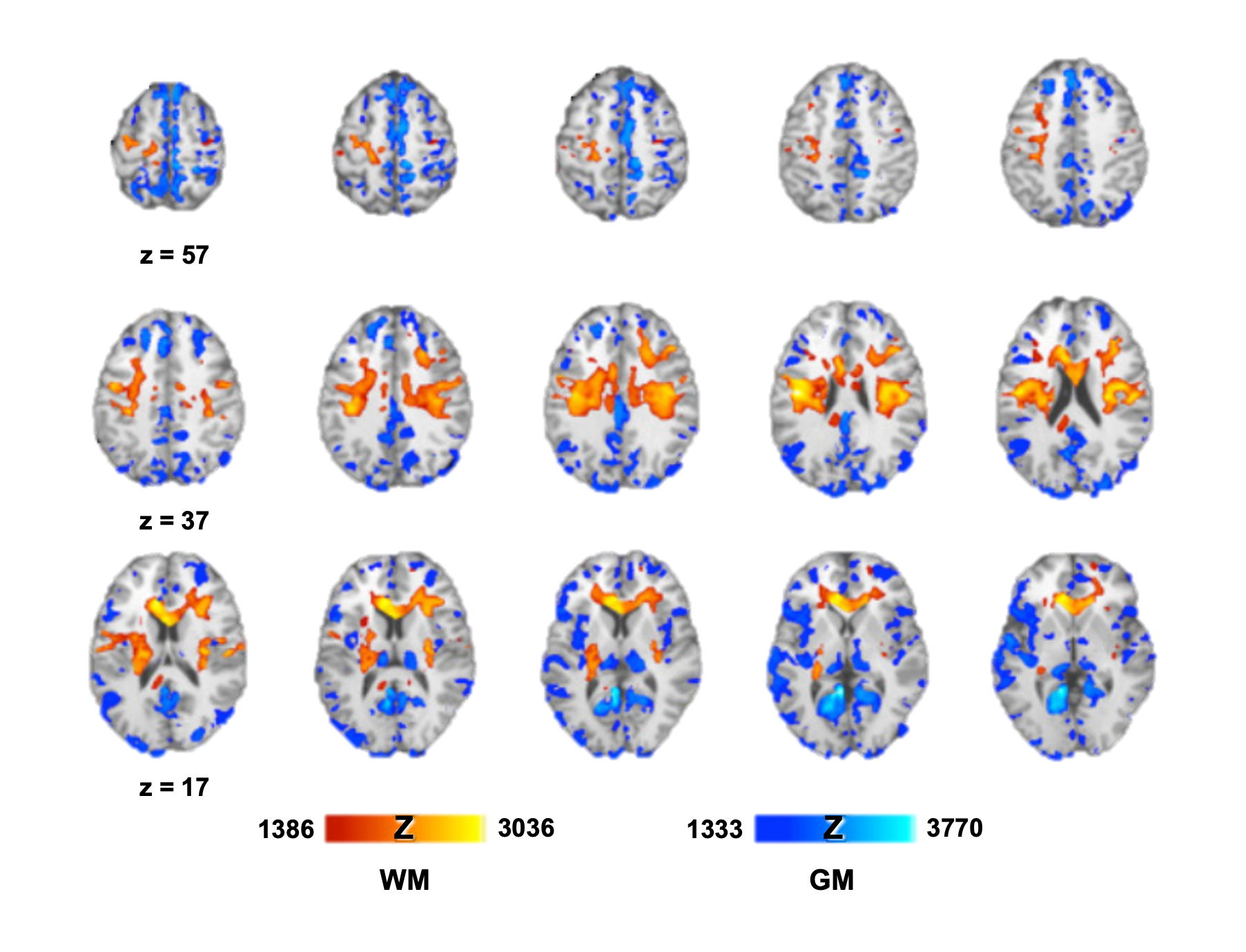 Neurocognitive and neuroanatomical maturation in the clinical high-risk states for psychosis: a pattern recognition studyLana Kambeitz-Ilankovic*, Shalaila S Haas*, Eva Meisenzahl, and 6 more authorsNeuroImage: Clinical, Feb 2019
Neurocognitive and neuroanatomical maturation in the clinical high-risk states for psychosis: a pattern recognition studyLana Kambeitz-Ilankovic*, Shalaila S Haas*, Eva Meisenzahl, and 6 more authorsNeuroImage: Clinical, Feb 2019Background: Findings from neurodevelopmental studies indicate that adolescents with psychosis spectrum disorders have delayed neurocognitive performance relative to the maturational state of their healthy peers. Using machine learning, we generated a model of neurocognitive age in healthy adults and investigated whether individuals in clinical high risk (CHR) for psychosis showed systematic neurocognitive age deviations that were accompanied by specific structural brain alterations. Methods: First, a Support Vector Regression-based age prediction model was trained and cross-validated on the neurocognitive data of 36 healthy controls (HC). This produced Cognitive Age Gap Estimates (CogAGE) that measured each participant’s deviation from the normal cognitive maturation as the difference between estimated neurocognitive and chronological age. Second, we employed voxel-based morphometry to explore the neuroanatomical gray and white matter correlates of CogAGE in HC, in CHR individuals with early (CHR-E) and late (CHR-L) high risk states. Results: The age prediction model estimated age in HC subjects with a mean absolute error of ±2.2 years (SD = 3.3; R2 = 0.33, P < .001). Mean (SD) CogAGE measured +4.3 (8.1) years in CHR individuals compared to HC (−0.1 (5.5) years, P = .006). CHR-L individuals differed significantly from HC subjects while this was not the case for the CHR-E group. CogAGE was associated with a distributed bilateral pattern of increased GM volume in the temporal and frontal areas and diffuse pattern of WM reductions. Conclusion: Although the generalizability of our findings might be limited due to the relatively small number of participants, CHR individuals exhibit a disturbed neurocognitive development as compared to healthy peers, which may be independent of conversion to psychosis and paralleled by an altered structural maturation process.
@article{kambeitz2019neurocognitive, title = {Neurocognitive and neuroanatomical maturation in the clinical high-risk states for psychosis: a pattern recognition study}, author = {Kambeitz-Ilankovic, Lana and Haas, Shalaila S and Meisenzahl, Eva and Dwyer, Dominic B and Weiske, Johanna and Peters, Henning and M{\"o}ller, Hans-J{\"u}rgen and Falkai, Peter and Koutsouleris, Nikolaos}, journal = {NeuroImage: Clinical}, volume = {21}, pages = {101624}, year = {2019}, month = feb, publisher = {Elsevier}, } - PhD ThesisElucidating the efficacy and response to social cognitive training in recent-onset psychosisShalaila S Haaslmu, Apr 2019
Neurocognitive deficits are one of the core features of psychosis spectrum disorders (PSD), and they are predictive of poor functional outcome and negative symptoms many years later (Green, Kern, Braff, & Mintz, 2000). Neurocognitive interventions (NCIs) have emerged in the last two decades as a strong potential supplementary treatment option to improve cognitive deficits and drop in functioning affecting patients with PSD. Social cognitive training (SCT) involving e.g., facial stimuli has gained considerably more attention in recent studies than computerized NCIs, that use basic visual or auditory stimuli. This is due to the complex character of social cognition (SC) that draws on multiple brain structures involved in behaviors and perception beyond default cognitive function. SC is also tightly interlinked with psychosocial functioning. Although they are cost-effective and quite independent of clinical staff, such technological approaches as SCT are currently not integrated into routine clinical practice. Recent studies have mapped the effects of SCT in task-based studies on multiple brain regions such as the amygdala, putamen, medial prefrontal cortex, and postcentral gyrus (Ramsay & MacDonald III, 2015). Yet, the degree to which alterations in brain function are associated with response to such interventions is still poorly understood. Importantly, resting-state functional connectivity (rsFC) may be a viable neuromarker as it has shown greater sensitivity in distinguishing patients from healthy controls (HC) across neuroimaging studies, and is relatively easy to administer especially in patients with acute symptoms (Kambeitz et al., 2015). In this dissertation, we employed 1) a univariate statistical approach to elucidate the efficacy of a 10-hour SCT in improving cognition, symptoms, functioning and the restoration of rsFC in patients undergoing SCT as compared to the treatment as usual (TAU) group, and 2) multivariate methods. In particular, we used a Support Vector Machine (SVM) approach to neuromonitor the recovery of rsFC in the SCT group compared to TAU. We also investigated the potential utility of rsFC as a baseline (T0) neuromarker viable of predicting role functioning approximately 2 months later. First, current findings suggest a 10-hour SCT has the capability of improving role functioning in recent-onset psychosis (ROP) patients. Second, we have shown intervention-specific rsFC changes within parts of default mode and social cognitive network. Moreover, patients with worse SC performance at T0 showed greater rsFC changes following the intervention, suggestive of a greater degree of rsFC restoration potential in patients with worse social cognitive deficits. Third, when referring to neuromonitoring results, it is important to state that only greater transition from ROP to “HC-like” SVM decision scores, based on the resting-state modality, was paralleled by intervention specific significantly greater improvement in global cognition and attention. Finally, we were able to show the early prediction of good versus poor role functioning is feasible at the individual subject level using a rsFC-based linear SVM classifier with a Balanced Accuracy (BAC) of 74 %. This dissertation sheds light on the effects and feasibility of a relatively short computerized SCT, and the potential utility of multivariate pattern analysis (MVPA) for better clinical stratification of predicted treatment response based on rsFC neuromarkers.
2015
- Master ThesisSeparation of recent-onset psychosis patients from healthy controls based on resting state functional connectivity pattern classificationShalaila S HaasAug 2015
Multivariate pattern recognition analyses (MVPA) have the potential to identify brain pattern alterations across the entire brain due to their capacity to extract the innate interregional dependencies of distributed brain pathologies from high-dimensional training data and generalize the learned discriminative rules to unseen patient cohorts (Kambeitz et al., 2015). While MVPA applied on structural data has been confirmed to be a very valuable biomarker for patients with psychosis (Koutsouleris et al., 2009), the MVPA classification based on functional connectivity FC alterations might be promising better sensitivity than structural measures (Kambeitz et al., 2015). Recent studies employing these methods have been able to show accuracies as high as 93 %, but these studies have focused on using resting-state functional magnetic resonance imaging (rsfMRI) data in order to diagnose patients in later stages with established schizophrenia (Wolfers et al., 2015). We used rsfMRI images from 19 healthy controls (HC) and 19 recent onset psychosis (ROP) patients obtained from PRONIA 1 to differentiate healthy from psychosis individuals. Correlation matrices between brain regions were used as features for multivariate analysis. The machine learning pipeline wrapped into repeated nested cross-validation was used to train a multi-modal diagnostic system and evaluate its generalization capacity in new subjects. Ultimately, the predictions of the different training partitions were combined into classifier ensembles, which provided a final group membership prediction through averaging. The top features were extracted in order to determine the regions of FC that were most discriminative for the classification. We found an overall classification accuracy, sensitivity, and specificity of 86.8 %, 78.9 %, and 94.7 % on rsfMRI data in patients with ROP and HC. In line with previous studies with ROP patients employing uni-and multivariate analyses of resting-state FC, we found an overall alteration in FC in widespread regions of the brain both inter-and intrahemispheric, but also with both long and short range FC between regions contributing to the classifier (Alonso-Solís et al., 2012; Fornito et al., 2011, 2013; Liang et al., 2006). Marked alterations occurred between various parts of the frontal lobe and the rest of the brain. When correlating the decision scores extracted from the classifier with neuropsychological scores, only the forward digit span, measuring short-term memory functions, showed significant results. Resting-state FC data can be used to discriminate ROP patients from HC.

























